FAQ - Using SMASHDOCs
Technical prerequisite
1What browser do I have to use SMASHDOCs?
We support all the latest versions of Chrome, Firefox, Safari both for Mac and Windows and Edge.
| Chrome | Version 133.0.6943.98 and above |
| EDGE | Version 133.0.3065.69 and above |
2What are the minimum system requirements for using SMASHDOCs?
| Processor (CPU) | 1 GHz or faster x86 or 64-bit processor with SSE2 instruction set |
| Operating System | Microsoft Windows or Apple MacOS |
| Memory | 2 GB RAM |
| Storage | 5 GB internal hard drive |
| Bandwidth | Outbound from the participant: 300 kbps |
| Inbound to the participant: 300 kbps |
3What are the system requirements to use SMASHDOCs on mobile?
| iOS | Version 10 or above |
| Android | Version 5.0 or above |
4How do I clear cache in the browser where I use SMASHDOCs?
For most browsers, you can use a standard "Ctrl + Shift + Delete" shortcut for the dialogue window with cache settings to be displayed. Here is the list of available shortcuts both for Mac and Windows users:
| Browser | Mac | Windows |
|---|---|---|
| Chrome | Shift + Command + Delete | Ctrl + Shift + Delete |
| Safari | Alt + Command+ E | no shortcut |
| Firefox | no shortcut | Ctrl + Shift + Delete |
| EDGE | no shortcut | Ctrl + Shift + Delete |
Shortcuts for cache cleanup
If there is no available shortcut for the browser you are using, you can google the instruction for cache deletion step-by-step.
5What is the reason that I get an error message?
If you get an error message "Something went wrong. Please reload the page.", there can be three reasons for that:
●there is no fixed connection to the internet
●several components are deleted very quickly
●the changes are decided upon one after another very fast
So please check if your internet is working properly and reload the page.
Registration and logging in the system
1Which fields are necessary to fill in during the registration?
Obligatory fields are:
●First name
●Last name
●Password
●Confirm password
Other fields, such as "Company" and "Position" are optional.
2Are there any requirements for the password?
Yes, there are. The password should consist of minimum 8 characters (letters, at least one upper-case letter, one number and one non-alphanumeric special character), the password must not contain any information from user ID (email/first name/last name), the password must be without characters that are repeated more than 3 times (e.g. AAA).
All these requirements will be indicated under the line "Password" in red, as soon as you start insert your password.
3I have registered but cannot log in, what can I do?
After successful registration with SMASHDOCs a confirmation mail with an activation link will be sent. Only after clicking on this link your account is activated and you can log in.
Occasionally it might also happen that a mail program considers this email as spam and moves it to the spam folder.
If the mail did not arrive or was accidentally deleted, you can have a new activation link sent to you by clicking on "Have you forgotten your password?
4I can not log in, what can be the reason?
If you cannot log in SMASHDOCs without any obvious reason, firstly try to delete the cash in the browser you are using (see 4). In case it doesn't help, then you can address SMASHDOCs Support Team by submitting a request from the login page. Click "Help" below the page and you will be redirected to the page where you can fill in the required information about the problem with login and send the support request.
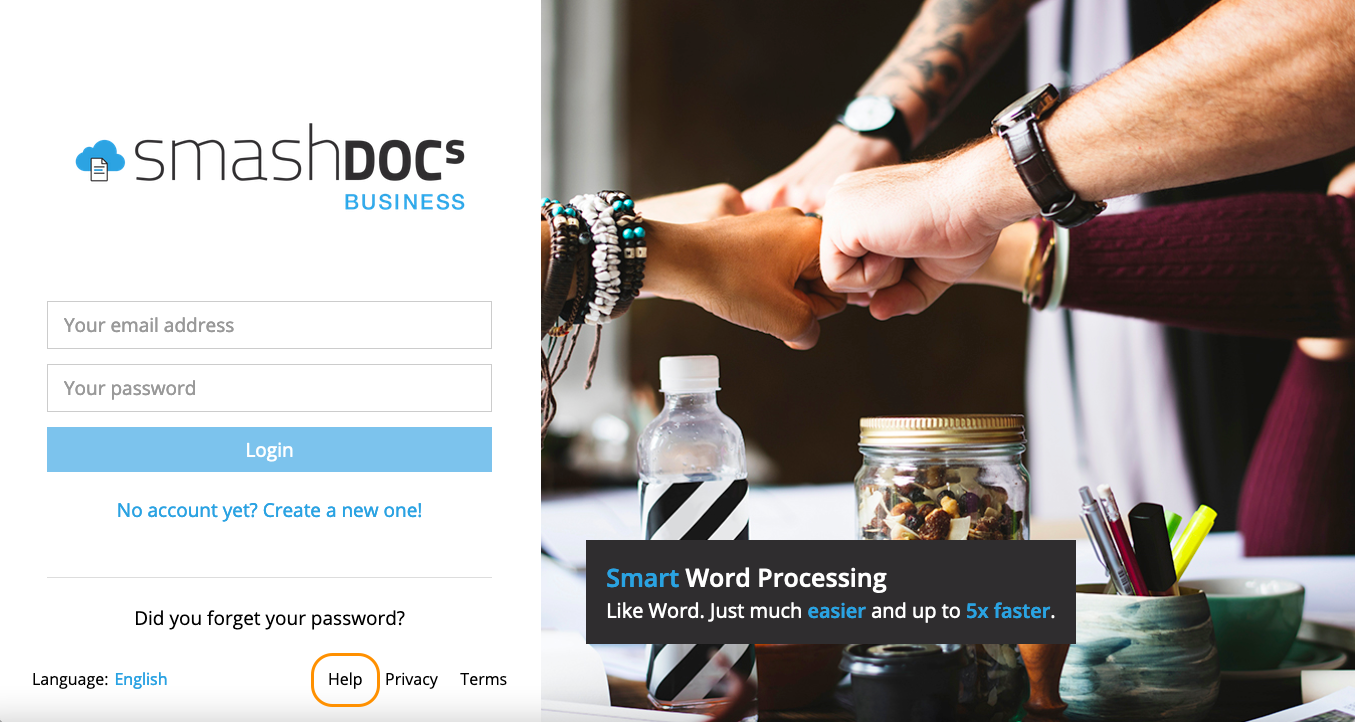
The button "Help" to submit a support request from the login page
5Can I log in with my Microsoft Office account?
If you have MS Office account, you can log in via "SignIn with Microsoft". Moreover, you can search a document in the connected SMASHDOCs app directly from MS Teams and add it as a tab in a channel with single-click, collaborate on the document with all the team members right away, invite users who do not have an Office 365 account or access to the team to your document by their email.
6Is there an option to change the language on the login page?
Yes, you can change the language directly from the login page. This option is placed in the left corner below the page. Click it and choose the required language from the list.
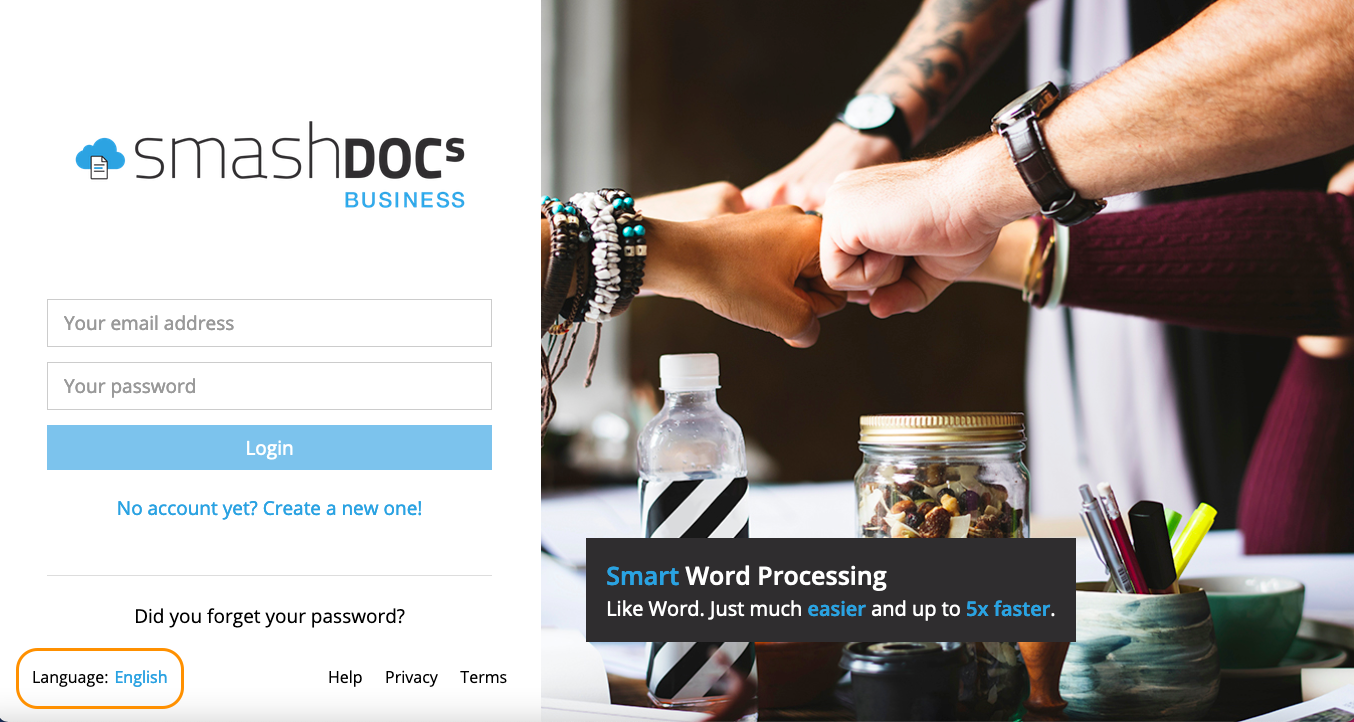
The option to choose language on the login page
Profile settings
1What languages do you support?
Currently, we support English, German, French, Belgian French, Canadian French, Dutch, Spanish and Russian.
2How can I change the language of my account?
To change the profile language, click on your avatar and select "Settings" and again "Settings". Then you can choose the desired language.
3How can I set the language of my document?
To set the language of your document you should open the settings of the document (in the left corner upwards) and define the general document language. This language then defines both spellcheck language and language by export.
4How can I download/change profile picture?
Click on your avatar and choose "Settings". Then click on the picture with your initials. Now you can simply drag and drop your new image to upload it or select an image from your computer.
5Can I change the date display in the system?
Yes, you can do it in profile settings. Choose one of the suggested date formats and you will get such a display everywhere, where the date is shown.
6How can I change my password?
To change your password, click on your avatar, select "Preferences" and again "Preferences", then go to "Security", there you can set a new password.
Note: your new password must not match 5 previous passwords!
7I forgot my password, what now?
To get a new password, go to the login page, click on "Forgot your password", enter your e-mail address. You will then receive instructions on how to proceed to set a new password on this e-mail address.
8Can I change my e-mail address?
No. Changing your email address is not possible.
9Where can I find an overview of my documents?
You always have an overview of all your documents in the "My Documents". It will be displayed immediately after logging in or when you click on the SMASHDOCs logo in the upper left corner of your open document.
10How can I delete my account?
To delete your SMASHDOCs account after successful registration, click on your avatar located in the right upper corner of the document list, then proceed to settings and choose the "Security" tab. In the bottom left corner click on "Delete account".
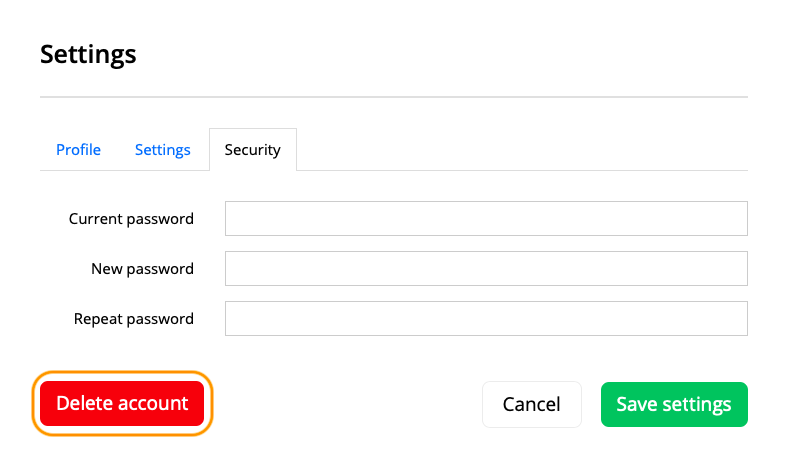
Tab "Delete account" highlighted in the settings menu
11How can I switch the tooltips on or off?
Tool tips are usage hints that appear when you hover your mouse over an icon. They show you which function is hidden behind this button.
You can switch it on or off by clicking on your profile picture in the document list and selecting "Settings". Under "Settings" you will now find "Show Tooltips". If you set a check mark for this they are switched on, without the check mark not.
Creating new documents
1How do I create a new SMASHDOCs document?
To create a new SMASHDOCs document, click on the green plus button in the lower right corner of the document overview and select "New document". A dialogue box opens in which you can enter the metadata of your document, such as file name, title and subtitle of the document, description, tags and a footer. Click on the button "Create document" to save the new SMASHDOCs document and you can start working on it.
A new SMASHDOCs document is always saved as a draft document, which can only be viewed and edited by you. No changes are logged in this mode until you press the button "Track changes" in the right upper corner. If you would also like to give other users access to it, you would have to share it for editing. To do this just press the button "Share" in the right upper corner of the document.
2What is the difference between the file name and the document title?
The document title is what appears as a heading in your export. So you don't have to add an extra heading to your document. You can specify the document in a more detailed way in the file name. Here is an example: if you are writing a manual, the document title would be "Manual Version 2.0". If you export your document, exactly this title will be set as heading. You can enter further information in the file name, for example "Manual for Copier XY, Version 2.0, German". This does not appear in your export.
The file name of the document is displayed in your document list. Of course, our search function takes both file name and document title into account in the keyword search.
3How can I rename the document?
Open the document, click on "Show document options" and select "Edit metadata". A dialogue box opens in which you can change the metadata of the document.
There are other options: via the document list. To do this, right-click on the document and select "Edit". You will get a dialogue box where you can change metadata.
Click on "Save document" to save the changes.
The process is the same to edit titles, subtitles, descriptions, tags and the footer.
4Why can't I rename the document?
You do not have the right user role or additional rights.
Only users with the role "Approver" and the additional "Admin" authorization can change the name of a document.
This applies to the document name, title, subtitle, description, tags and footer.
For more information about the user roles, read FAQ 138.
5How do I access the document list from an open document?
Click on the SMASHDOCs logo in the upper left corner and you will return to your document list.
6How can I copy a document?
To copy a document, right-click on the document in the document list, or left-click on the context menu button and select "Copy".
You will then see a dialog box in which the reference data of the new document can be entered. After clicking on "Save document", the document will appear in the currently displayed document list.
7Can I create and edit documents on my phone or tablet?
You can edit your documents with SMASHDOCs mobile app using iOS or Android operation systems, however, it is not possible yet to create new documents there. Apart from editing you can also track changes, decide on suggested changes, leave comments and answer on existing ones while on the go. More information about SMASHDOCs mobile app is in the Mobile app manual.
8Can I edit documents offline?
No. SMASHDOCs is a pure web application, i.e. you always need an internet connection to work with it.
Projects
1Is it possible to combine documents into projects?
Yes, with our "Projects" functionality you can create separate projects and add there as many SDs as you like. This way, all documents related to, lets say, marketing project are located in one place and can be later on exported as one. More information about creating a project you can find here Module "Projects".
2I want to add documents to the project but there are no documents displayed in the list. What should I do?
Initially, there are no documents displayed in the list after you press "Add documents to the project". You have to fill in the search field with the desired search term for documents to appear in the list.
3Is it possible to combine several documents into a single one with the help of the option "Projects"?
It is possible to do that. You can add as many documents as you like into your project, choose all or some of them and generate those into one document.
4If I delete the project containing several documents, will those documents be deleted as well?
No, if you delete the project, you are still able to find those documents in "My documents" folder.
5What if I delete the document right from the project? Will it be deleted everywhere?
No. It will only be deleted from the project and not from SMASHDOCs itself.
6Is there some way to export several documents at once?
With our "Projects" functionality you are able to add multiple documents to your project and then choose which ones and in what order should be generated. Moreover, you can also choose between three options as generating new SD in draft mode, exporting the document to WORD or PDF formats.
Editing documents
1Can I change the font in SMASHDOCs?
You can choose which font you want to use in your SMASHDOCs document in the formatting menu. Whether these settings are transferred into the export format depends on your stored template. With SMASHDOCs Premium, your document is exported directly to the format you set, so you don't have to worry about the right font and formatting. With a standard export you can then adjust the font in the Word document.
2Can I change the font size in SMASHDOCs?
You cannot change the font size but you can always zoom in via zoom button and enlarge texts in components, tables, image/table captions. You can also use the key combinations "Ctrl + / Ctrl - " for Windows and "COMMAND + / COMMAND - " for Mac.
Default is 100%.
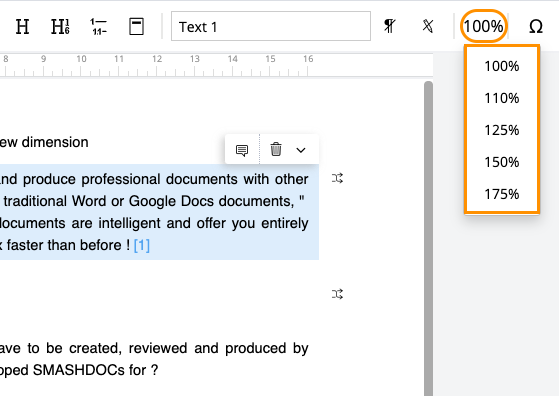
Zoom button highlighed
3How can I insert a new text component?
Click on a text component and press ENTER to create a new text below it.
4Can I also insert content from other SMASHDOCs documents and external sources?
Yes, that's possible.
Just copy the text passages you want to paste into your SMASHDOCs document with Ctrl / CMD + C and paste them with Ctrl / CMD + V to the desired location.
SMASHDOCs creates a new component for this.
If you want to insert the text passages into an existing component, you should use the key combination Ctrl / CMD + Shift + V.
5Can I also merge the components?
If the document is in the draft mode (and changes are not recorded), the procedure is analogous to WORD.
If the document is in the review mode, in which changes are recorded in each component, you can also merge two components via BACKSPACE at the beginning of the component. The additional confirmation is required, though.
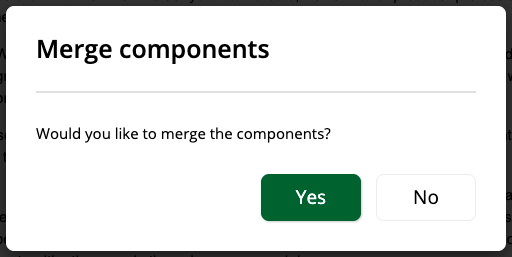
Confirmation after pressing BACKSPACE for merging components in the review mode highlighted
6How do I change the orientation of the page to landscape format?
To change pages orientation, go to the context menu of the text/image/table component, click on "Others "and choose "Change to landscape format ".
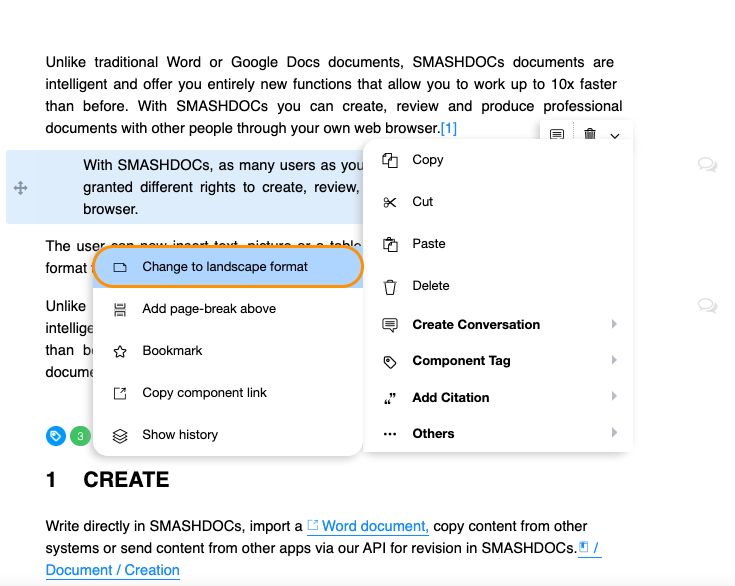
Option "Change to landscape format" highlighted
Once you have applied the landscape orientation, you will notice the orientation separator "Landscape" on the top of the component. Please note that using the landscape format in a particular component will apply it to all the subsequent components until you change it back to the portrait mode.
Important: changing to landscape format in a document shared for review is available exclusively for users with roles "Suggest", "Approver".
Also, be aware that the orientation switches are not visible in the SMASHDOCs editor and get applied only in the exported file.
7How can I delete a component?
Click on the component you want to delete. A small trashcan icon will appear at the top right of the component, click on it.
In draft documents, the component is then completely deleted and cannot be restored.
In documents that shared for review, the component is then adjusted as a red strikethrough text and suggested for deletion.
8How can I create a heading?
To turn existing text components into headlines, click with the left mouse button on the text component that you want to have as headlines. Then click on "Heading" at the top of the formatting list and select the heading level.

Creating an unnumbered heading highlighted
9How can I create headings with outline numbers?
If you want to number a heading, left-click on the component of text you want to number. In the formatting list at the top, click on "Heading - outline numbered" and select the heading level.
SMASHDOCs always offers you the logically correct numbering. Even if you move the headings with numbering, the remaining numbering is automatically adjusted.
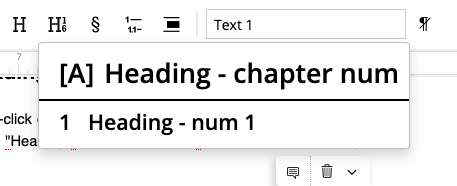
Creating an outline-numbered heading highlighted
10How can I move the text components?
The text components can be moved in both draft and review modes.
To do this, left-click on the component you want to move, move the mouse to the left edge of the area where the "handler" appears. Click with the left mouse button on this handler and drag the component to the desired position.
11How can I create a list?
Select the components to be numbered. Please, note that the components you want to select should be directly below each other.
Click on "List" in the formatting bar and components will be formatted.
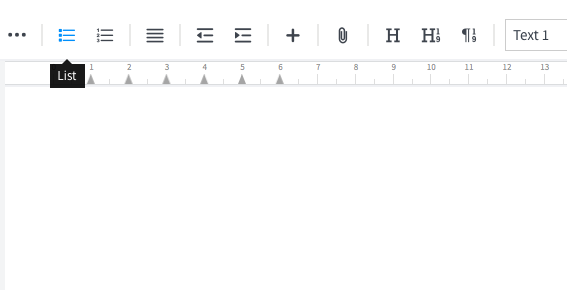
Creating an unordered list highlighted
12How can I create numbered lists?
Select the components to be numbered. Please note that components you want to select should be directly below each other.
Click on "List-numbered" in the formatting bar and the components are formatted.
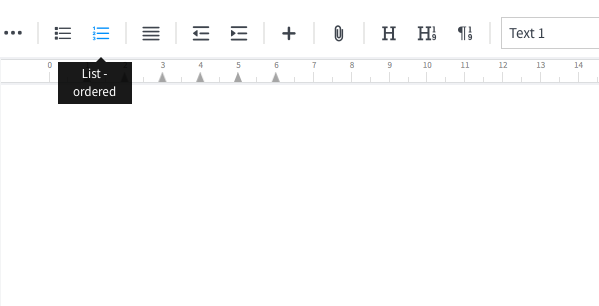
Creating an ordered list highlighted
13How can I format the text?
To format a text, left-click on the text component or particular words.
Select one or more formatting functions from the formatting bar at the top or from the formatting settings menu on the left sidebar. The entire component or the selected words will be formatted accordingly.
The following formatting options are available for text:
Bold
Italic
Underline
Strike through
Transcript
Small caps
Superscript
Subscript
Highlighting
Alignment (left, right, centered, aligned)
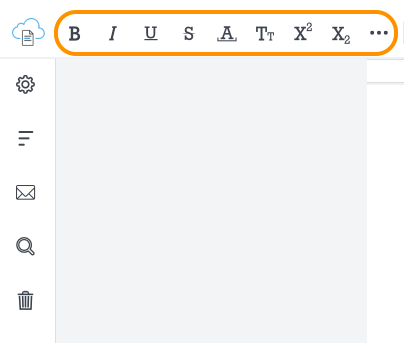
Formatting options for a text highlighted
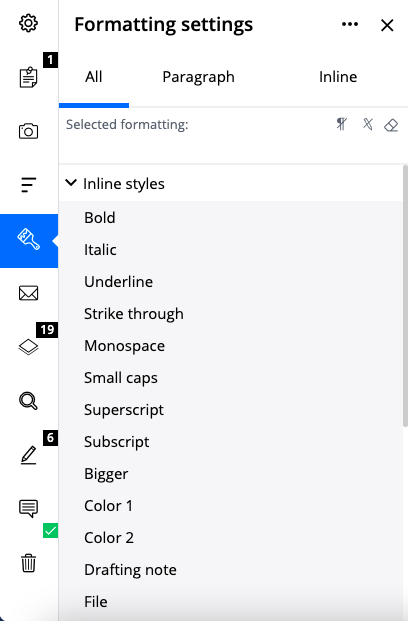
Formatting settings menu on the left sidebar
14Can the text in SMASHDOCs be colored?
In the standard version of SMASHDOCs it is impossible to highlight the text in color.
The user can only select background color.
Please note: the background color settings are not applied after the exporting option, therefore we recommend you to make text color changes only after export to the desired format was done.
15Can I find out how many words there are in my SMASHDOC?
Yes, you can do that either for the whole document or for the chosen component only. To get an overview of the number of words/characters, with and without spaces, go to the "Show document options" tab and click on "Word / character count''. You can exclude footnotes manually by ticking the corresponding line. This checkbox is switched on by default.
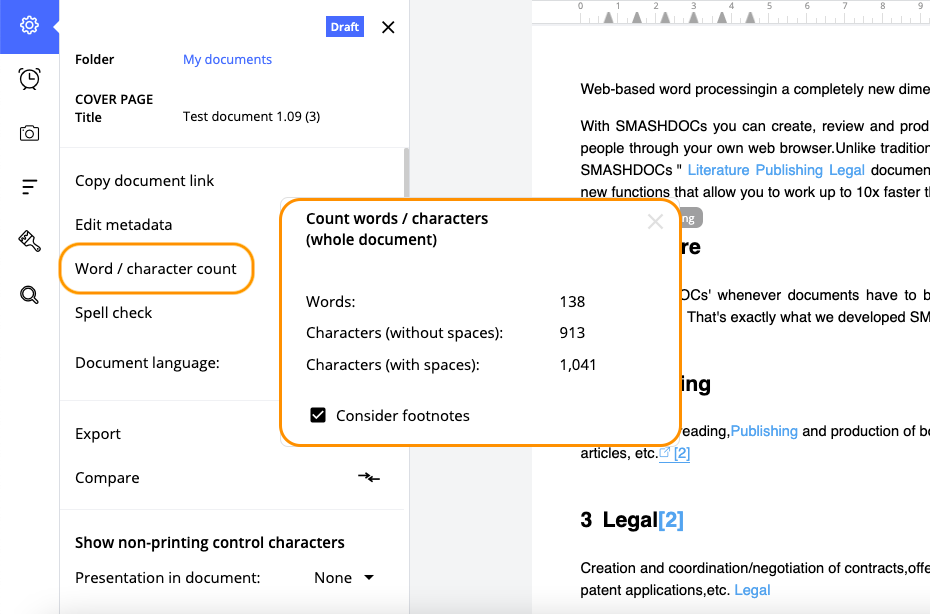
"Word / character count" highlighted
To see the word/character statistics of chosen components, select required components and you will receive requested report.
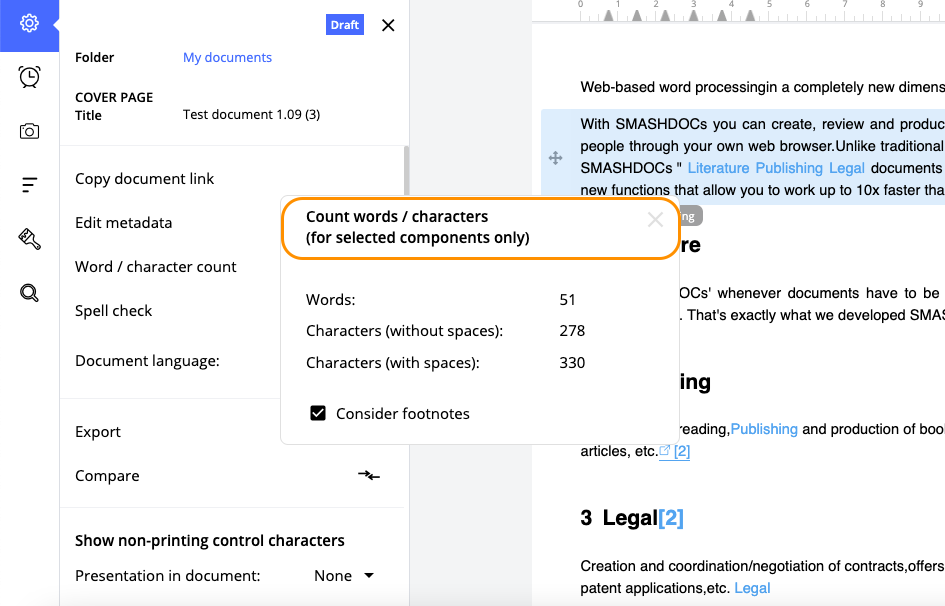
Word/character report of chosen components only
16If I delete a word, but not accept this deletion, will I see changes in the Word count report?
Yes, you will. No matter, if you have accepted deletion or not, there will be displayed less counted words in Word count report after deletion.
17Can I also work with keyboard commands in SMASHDOCs?
In every SMASHDOCs document you can also work with keyboard commands. Here you have an overview, some key combinations there are:
1.Components (basic)
●Cut out: CMD/STRG + X
●Copy: CMD/STRG + C
●Insert: CMD/STRG + V
●Save changes in a review component: CMD/STRG + S
●Release draft component for revision: CMD/STRG + SHIFT + S
2.Save weblink: TAB + Enter
3.Save footnote: TAB + Enter
4.Comments / Questions
●Create Comment/Question: TAB + Enter
●Answer the comment / send question: CMD + Return
5.Tables
●Line break in tables: CMD/CTRL + Enter
To see the list with all shortcuts available in SMASHDOCs, simply click on the "Shortcuts list" button in the menu under your avatar.
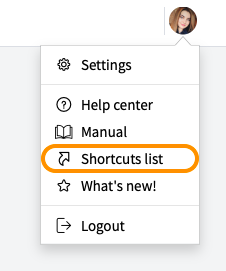
List with all shortcuts highlighted in the menu under avatar
18How can I clear format with the help of the corresponding key command?
To remove format with a shortcut, you should select the required text or place the cursor in the middle of the formatted word. Then perform shortcut "Command + D" for MacOS or "Ctrl + Space" for Windows OS. After that, format will be cleared.
19Is the special character Soft return available in text components?
Yes, you can apply soft return in all text and footnote components.
20How can I select several components of text at the same time?
Right-click on the text component, print and hold Shift for Windows or Shift+CMD for MAC users. Then click on the other text component above or under.
All components that lie between the two selected text components will be selected.
Unfortunately it is not possible to select several components from different parts of the document.
By selecting several components you have the possibility to do more at the same time:
●Move the components (within the document)
●Release for revision (in draft components)
●Accept or reject changes
●Create lists (numbered)
●Format
●Copy
●Delete
21How are changes saved in text components?
If you have not yet released your document for editing, changes are saved automatically. After sharing with other users, your changes are automatically saved in review components when you click outside the component. You can also save the changes manually using the key combination CMD/ CTRL + S or you can click on the green button that appears in the top right-hand corner as soon as you make new changes.
22Which ways to paste copied or cut content are there in SMASHDOCs editor?
You can paste content only by performing key command Cmd+V in MacOS or Ctrl+V in Windows. Due to particular browser security regulations you cannot do this with an option "Paste" from context menu. In this case the following warning message will appear:
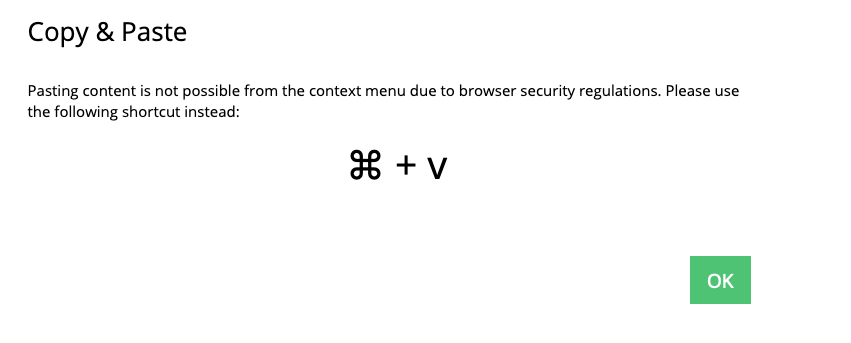
Warning message concerning copy&paste options
23How can I insert the changes in review mode?
If you want to correct something in review mode, left-click on a component where you want to insert suggestions for changes. After you have done everything necessary, there are several ways to save:
●Click the green button at the top right of the component
●Activate the key combination Ctrl / CMD + S
●Just click outside the component
Note: the suggestions for changes can only be inserted if you have the role "Suggest" or "Approver" and the component has already been shared for review. In the case of a design component that you have not created, editing is only possible once it has been released for editing.
24How can I release a draft component for review?
To release a design component for revision, click on the design you want to release for review. A blue arrow appears at the top right corner, click on it, and the component is shared for review by other users.
25Can I see draft components created by other users in my document, as well?
Yes, there is the "Other users" filter in the list of draft components in the left toolbar, which you should activate to get the overview of draft components created by other users.
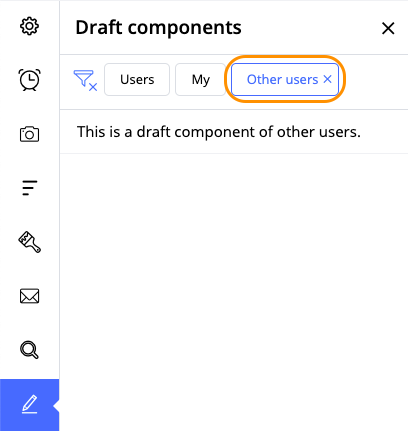
Activated filter "Other users"
26If there are many users in the document who created draft components and I need to see the draft components of one particular user, can I separate these draft components in the list?
To see draft components created by particular users you should activate the "Users" filter, then select required users and click "Go". After that, the draft components of selected users only will be displayed in the list.
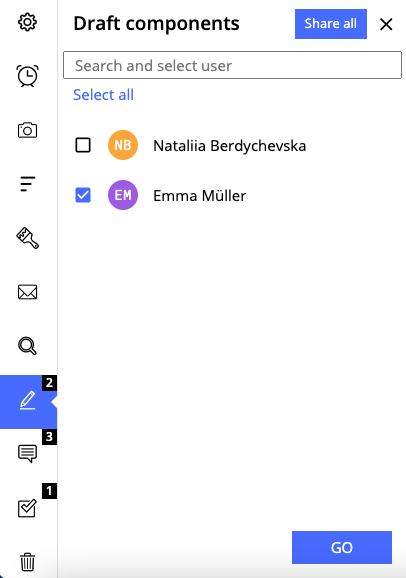
The list of users who have added draft components
27What happens, if I deselect all users in the filter?
In case you deselect all users, the button "Go" will be disabled.
28Why is the tab for draft components displayed without a number in the left toolbar?
This outlook means that you do not have your own draft components and only draft components of other users have been added in the document.
29How can I check if there are other components that I have created and that I still need to approve?
If you still have draft components in the document you want to publish, the "Show all my draft components" tab appears on the left side of the tab bar in the open document. This will give you an overview of all your own draft components in the document.
The grey number shows how many draft components you have in the document that you have not yet released.
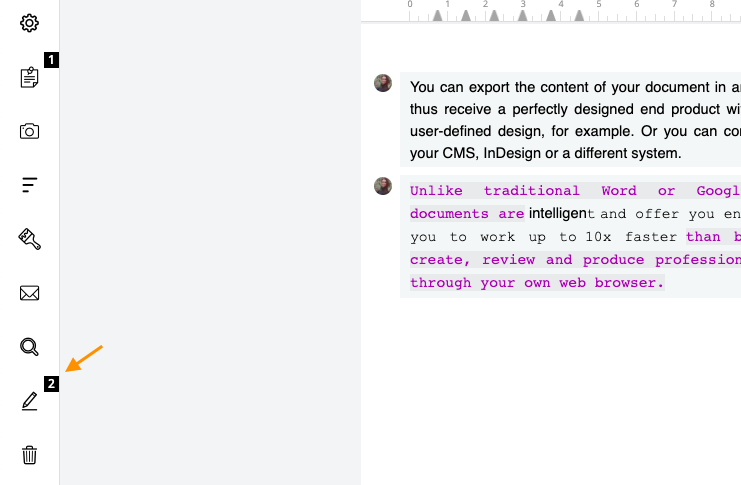
Tab "Show all my draft components" highlighted in the tab bar
If you click on a component in the list, you will be sent directly to the corresponding position in the document.
You can also immediately release the draft component for revision by clicking on the small check mark.
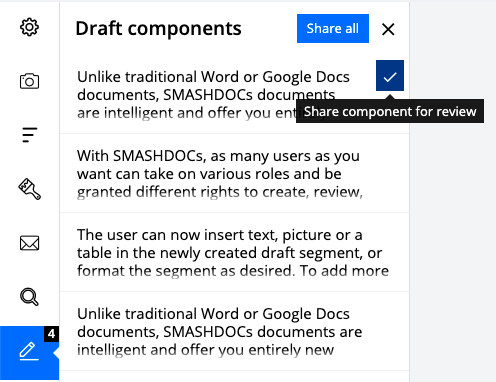
Tab "Share component for review" highlighted in the tab bar
With a click on the button "Share all" you can release all draft components at the same time.
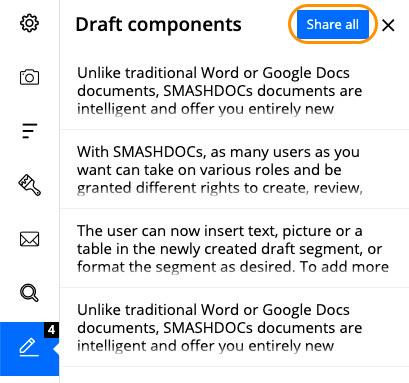
Tab "Share all" highlighted
30How can I incorporate suggestions for changes?
To include suggestions for changes, click on the desired component and start typing in the changes directly. When you are done, click on the green button at the top right corner, press Ctrl/CMD + S or simply outside the component and the changes will be saved.
Please note: You can only add changes in review components and only if you have the user role "Suggest" or "Approver"!
31Who can decide on proposed changes in the document?
Changes to the document can only be accepted or rejected by users with the role of "Approver". Users with the role "Suggest" can only incorporate changes, but cannot decide about them, "Commentator" is allowed to write comments on components only, and "Reader" can only read the document, but neither edit it nor write comments on it.
32How do I mark changes as seen?
You can mark new changes in a document as seen by clicking on the "blue eye" that appears to the right of each component that contains new changes.
If you have a document with many new changes, it is easier to call up the list of all changes in the document in the table bar on the left to get a better overview. The number highlighted in red shows you how many new, unseen changes there are in the document.
This list gives you information about all unseen as well as all open (pending) changes in the document. By clicking on a change, SMASHDOCs immediately shows you the corresponding position in the document and you can view it directly. Here you can also mark an unseen change as seen by clicking on the "blue eye". You should mark all changes to inform SMASHDOCs that you know about them. Later on you can accept or reject the changes.
It is also possible to mark all new changes in the document as read at the same time. Click on the blue button "Mark all as read" in the header and all unseen changes are marked as read.
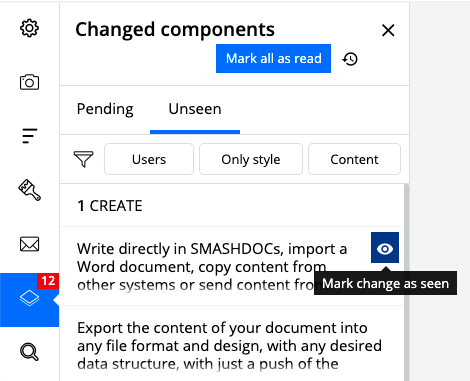
Options for marking changes as seen highlighted
33How can I accept changes?
Please note that you can only accept changes if you have the role "Approver"!
If there is an open change in the document that you want to accept, first click in the corresponding component with the open change and then on the green button at the top right margin.
An open change is displayed either as green (something has been added) or as red strike through text (something has been deleted) in the document. If you accept an added text, the component is updated and the text turns black again. If you accept the deletion of a text or individual words, they disappear from the component.
34How can I reject changes?
Please note that you can only reject changes if you have the role of "Approver"!
If there is an open change in the document that you do not like and you therefore want to reject it, first click in the corresponding component with the open change and then on the red button at the top right margin.
An open change is displayed either as green (something has been added) or as red strike through text (something has been deleted) in the document. If you reject added components or words, they disappear. If you reject the deletion of a component or words, they remain in the document and the text turns black again.
35Can I filter changes by the user that made them?
Yes. It is possible to select certain users and only their changes will be highlighted.
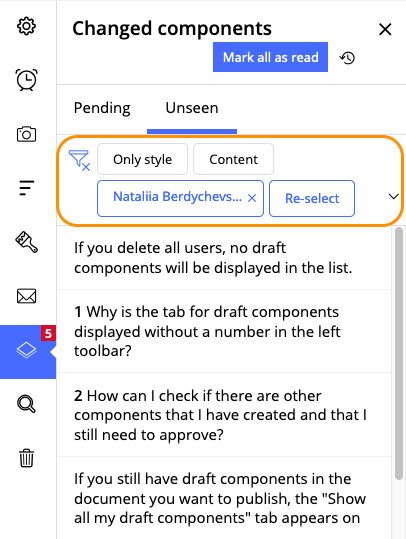
Changes of selected users highlighted
36Can I accept / reject all changes of a certain user with just one action?
Yes, but you should first hide the changes from all other users in the document. To do so, deactivate the checkboxes next to the irrelevant users and click "Go". The list of changes will be adjusted accordingly. Then choose either “Accept all” or “Reject all” and all the changes made by the specific user will be processed at once.
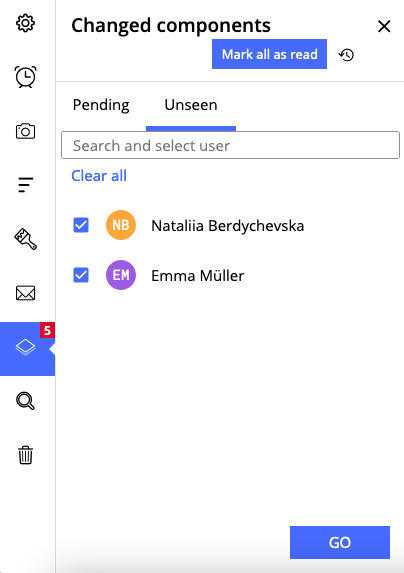
Filter "Users" highlighted under the "Changes components" tab
37I have filtered changes by certain users but after reopening the document all users were selected again. Why?
Every time you reload/reopen the document, all users in the document are being automatically selected.
38If I want to restore the component version created by the deselected user do I have to select him again?
Although entries of deselected users are greyed out from the list of component versions, the option to restore such version remains.
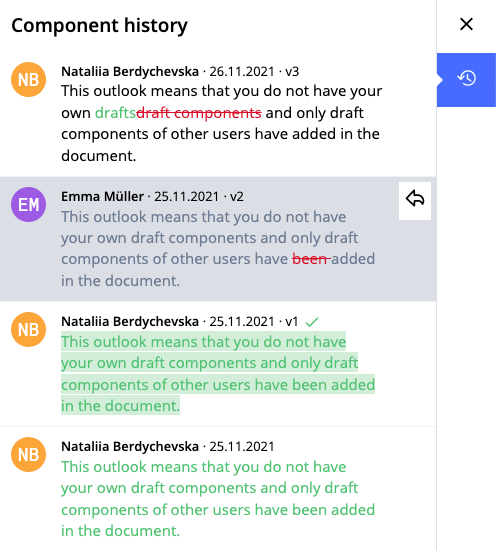
Restoring versions of deselected users
39Why can't I change the contents of a document shared for review?
In this case you do not have the required user role. You can only edit the content of documents that are released for revision if you have the role "Suggest" or "Approver".
40I deleted a component completely - can I undo it?
It is not yet possible to restore deleted draft components in a document released for editing.
However, on the left side of the tab bar, you have an overview of all deleted review components in the archive. If you should have deleted something unintentionally, you can look there and re-enter the component.

Archive of all deleted review components highlighted
41What is a component history?
The component history is an overview of which user inserted, deleted, accepted or rejected which changes and when. The list is made in chronological order.
It is displayed either via the component menu under "Show history" or by clicking on the number to the right of each component.
42How can I find out who inserted the content if there has been no component history yet?
If the component was shared for review but has no component history yet, go to the component menu and choose the option "Others" => "Show history". The name of the user who created the component will be displayed.
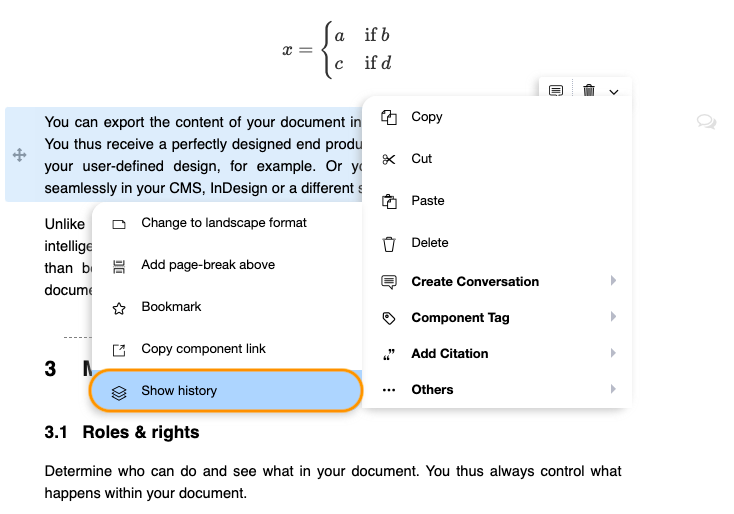
Option "Show history" highlighted in the component menu
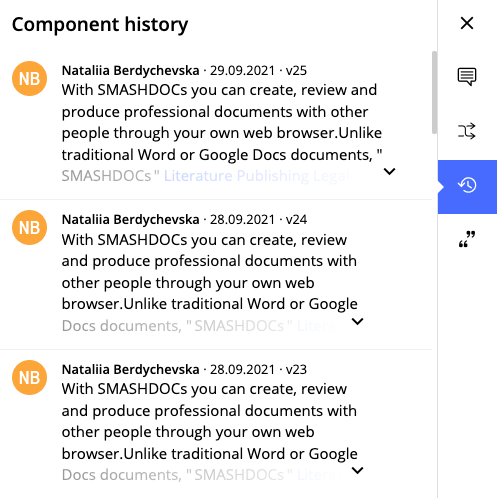
43Where can I view the component history?
You can call up the component history for any component, whether text, image or table, either by selecting "Show history" in the component menu or by clicking on the small number to the right of the component, which by the way shows you the number of all changes in the component.
44I like an older version of a component better than the current one - can I restore the older formulation?
Yes, by going back to a previous version via the component history.
To do this, open the component history and select the component version you want to restore. Then click on the grey button at the right margin and the component will be updated according to the selected version.
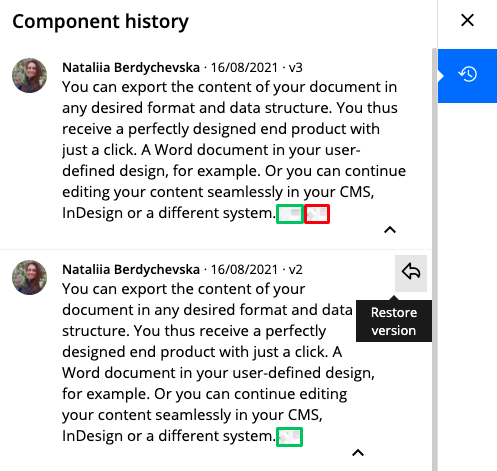
Tab "Restore version" highlighted in the component history
45Is it possible to restore version of a component that contains footnotes?
Yes, this option is available for components with footnotes, as well.
46Why do I get error notifications during restoring versions with footnotes?
These notifications do not inform you about error, instead, they prevent you from performing an undesirable action. For instance, if there is a footnote in the current version of a component, but you click a rewind button in the version that does not contain a footnote, you get a message that in this case footnote will be deleted after restoring. You can proceed or cancel this action.
Another notification appears in the case, when a footnote was added by one user and is currently in draft mode, and another user wants to restore version of a leading component with this footnote. In this situation restoring version is unavailable. Notification points out that this footnote should be firstly shared for review or deleted.
47What do the different colors and underlays in a document released for editing mean?
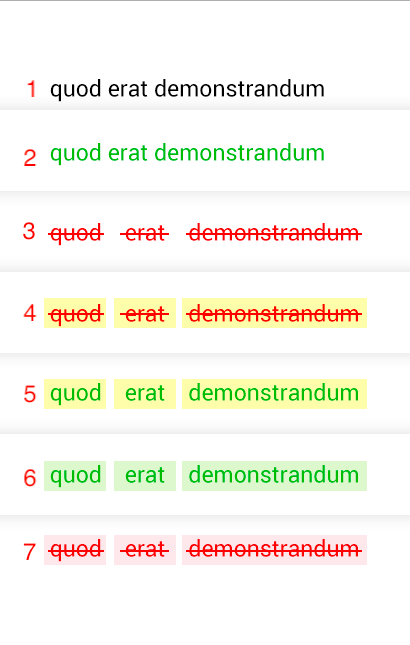
1.Normal text.
2.This text was changed by the user himself or is already marked as seen but the decision is got to be made still.
3.This text was deleted by the user himself or is already marked as seen but the decision is got to be made still.
4.These rejected changes were not marked as seen yet and the decision is got to be made still.
5.These added changes were not marked as read yet and the decision is got to be made still.
6.The accepted insertion or rejected deletion that was not marked as read yet.
7.The rejected insertion or accepted deletion that was not marked as read yet.
48How can I insert new components in a document that has been released for editing?
Inserting new components in a document shared for editing works exactly like in a design document, see FAQ (How can I insert new components into a draft document?) . However, there is a decisive difference:
In a document released for editing, new components, whether text, image or table, are always first created as draft components.
This allows you to incorporate new content at your leisure and only release the component to all other users in the document for revision when you are done with it. To do this, click on the blue "Share for review" button at the top right corner of the draft component. Only after approval can the component be edited by other users as usual, in draft mode only you can edit the content of the component.

Tab "Share for review" highlighted on the top right margin of the component
You can recognize your own draft components in the document by the light blue background. In addition, your profile picture appears on the left edge of the component so that you can see at first glance which components belong to you. A "lock symbol" appears on the right margin, so that you can immediately remember the component as closed. When released, these disappear again and the component becomes a review component.
Draft components of other users can be recognized by the white-grey striped background and the lock symbol on the right side of the component. The profile picture on the left side shows you who created the design component.
Draft components of other users are blocked for you and can only be edited by the users who created them. However, you have the possibility to release draft components from other users for revision or to delete them if you are admin of the document and/or have the role of "Approver". However, it is always possible to move draft components, even those of other users and even if you are not an admin and/or are not "Approver".
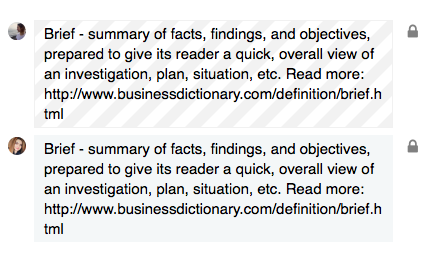
Draft component created by users with different roles highlighted
49How can I insert new components into a draft document?
To insert new components into a document, press the ENTER key and a new component appears.
If you want to insert an image, you can drag it directly to the desired position in the document and the image component will be inserted automatically. Alternatively, you can click on "Insert image" in the formatting bar and an image component will be inserted.
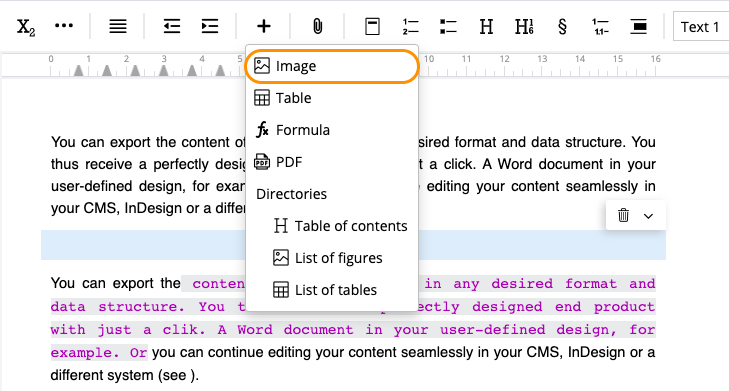
Tab "Insert image" highlighted in the formatting bar
The same applies to tables. Alternatively, you can insert a table component via the formatting bar by clicking on the corresponding button.
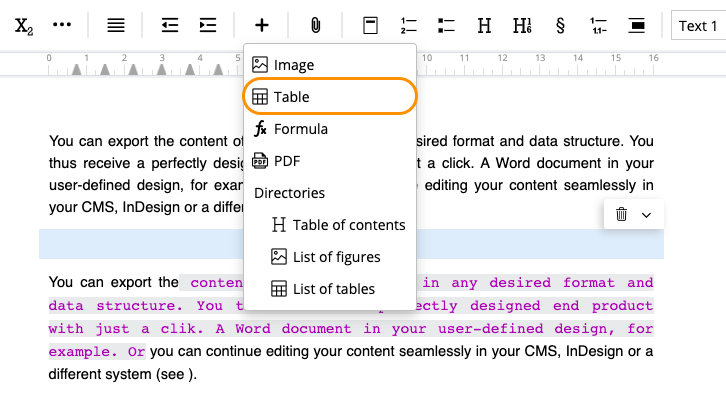
Tab "Insert table" highlighted in the formatting bar
50What is a component link?
A component link is an individual link to the component. Each component in SMASHDOCs document has such a command through this link.
51Why do I need a component link?
Each component in the SMASHDOCs document has a command through the individual link. You can send it so that the recipient lands directly on the corresponding component when the link is called and should not search long for it.
52How can I insert (numbered) lists into a document?
For lists, you can choose whether you want to number them or not. For both cases, select the components to be numbered and click in the formatting bar either on "List" or on "List-ordered" and the components will be formatted accordingly.
53How can I superscript or subscript a part of a word?
For technical reasons you can only superscript or subscript words as a whole. Mark the word you want to superscript or subscript and then click on the corresponding button in the formatting bar, see the following illustration.
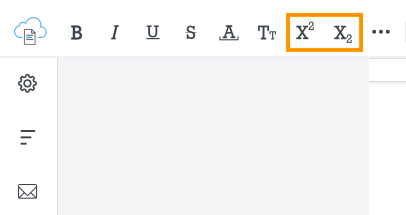
Tabs "Superscript/Subscript" highlighted in the formatting bar
But beware, tip from the professional: Simply separate the part of the word you want to superscript or subscript with a space from the rest of the word. If you now raise or lower the separated part, the space will disappear and your thus formatted word part will be moved back to the non-formatted part.
54How can I insert a page break?
Right-click on a component of text in which you want to insert a page break. Select "Add page-break above" from the context menu.
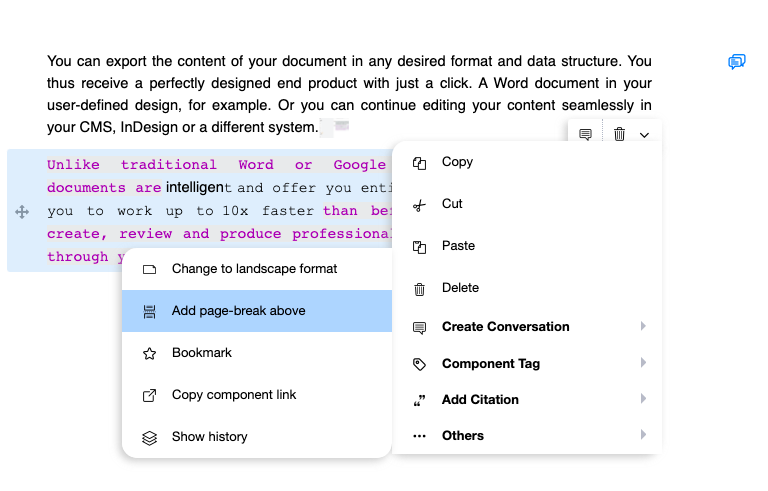
The option "Add page-break above" highlighted
55Is the number of indexes limited for creating?
No, you can create as many indexes, as you need.
56Is it possible to remove index link from the text?
Yes, you can do this at any time you want. Just click on the corresponding index link and in the opened modal window select the option "Remove index link".
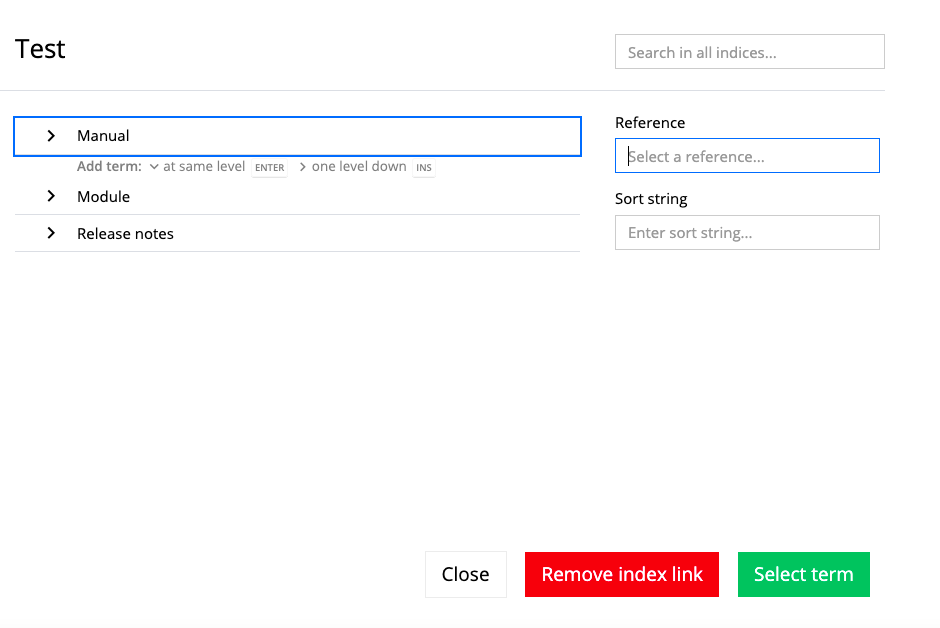
The option "Remove index link" displayed
57Can I add more than one index link to the document at once?
It isn't possible to add several index links at once, but you can add as many links as needed in the same place one after another.
58Are changes in indexes and index links tracked in the component history?
No, changes in indexes are not documented in history.
59Can I find the list of all index links that have been added to the document?
For that you have to open the tab "Show directories", there click three dots and choose "Indices". Then you will get the list of all indexes and index links that have been inserted in the text at different points.
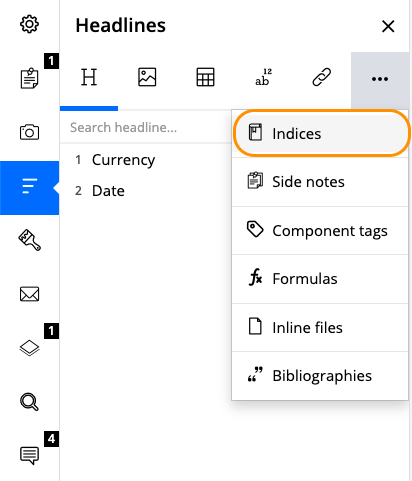
The list of indexes in directories
60Can I run a spellcheck?
Yes, you can. In case the spellcheck option is enabled for your organization or a particular document, it will run automatically. If not, you can always go to the toolbar on the left, click on the "Show document options" and activate the "Spellcheck" box. Below you can choose the document language. After you close "Show document options", the new settings will apply.
61Can I work with some kind of template document?
Yes, SMASHDOCs actually offers such template-based option for your personal needs. It's created in form of an interview where you are answering the questions and filling in the information in the desired document, for instance, a contract, without having a need to find the gaps where such a piece of information is needed yourself. It's called "SmartDocuments Interview", you can find more about that here https://service-description.smashdocs.net/smartdocuments-interview.
62Can I communicate with other users in real time while editing documents, for example by chatting with them?
In SMASHDOCs you have the possibility to communicate with other users in real time via the document-internal comment function. In FAQ (How can I add a comment to a certain text of a component?) and (I would like to send a comment only to certain users - is that possible?) we show you how to add comments to your document and how to send them to specific users. It is also possible to have very private conversations.
63How can I find required headlines in my document quickly?
You have to choose function 'Show directories' on the left side, then insert words or numbers of a headline that may help you find it and you will see the needed headline. Click on the headline you have found and you will be able to edit a required part of your document.
Division separators
1Can the list of division separators be configured separately for the system?
Yes, the list of division separators can be set according to customer specifications.
2Can I edit or delete division separator after inserting it in the document?
It is only possible to edit settings for page numbering. You cannot change the division separator.
3What does the point "OncePerDoc: false" in metadata of division separator mean?
OncePerDoc is displayed to indicate, whether the applied division separator is unique and can be used only once per document, or it can be several times within one document. If the meaning is "False" - you can apply this division separator several times, if "True" - only once in the document.
4Is it possible to change the position of division separators in the document?
Yes, you can do this by holding the corresponding sign and moving a separator to the desired point in the document.
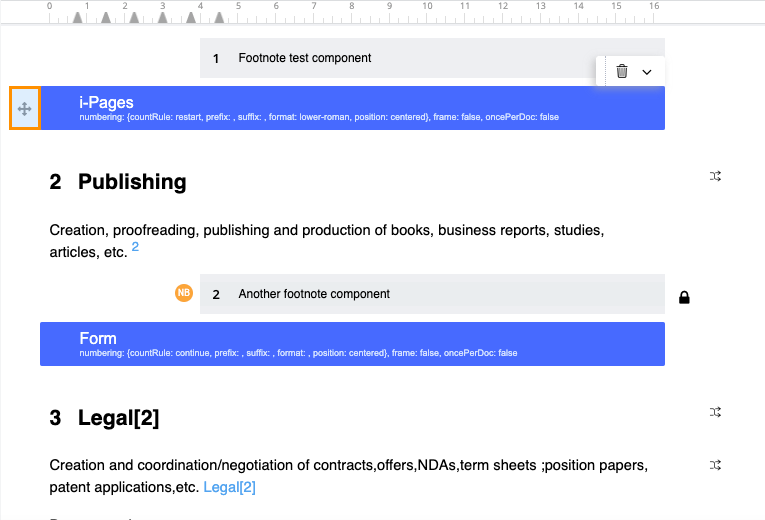
Button to move division separators to the other places in the document
5Can I create a new division separator?
Yes, there is an option to create individual division separator and then set name and key of a newly created separator.
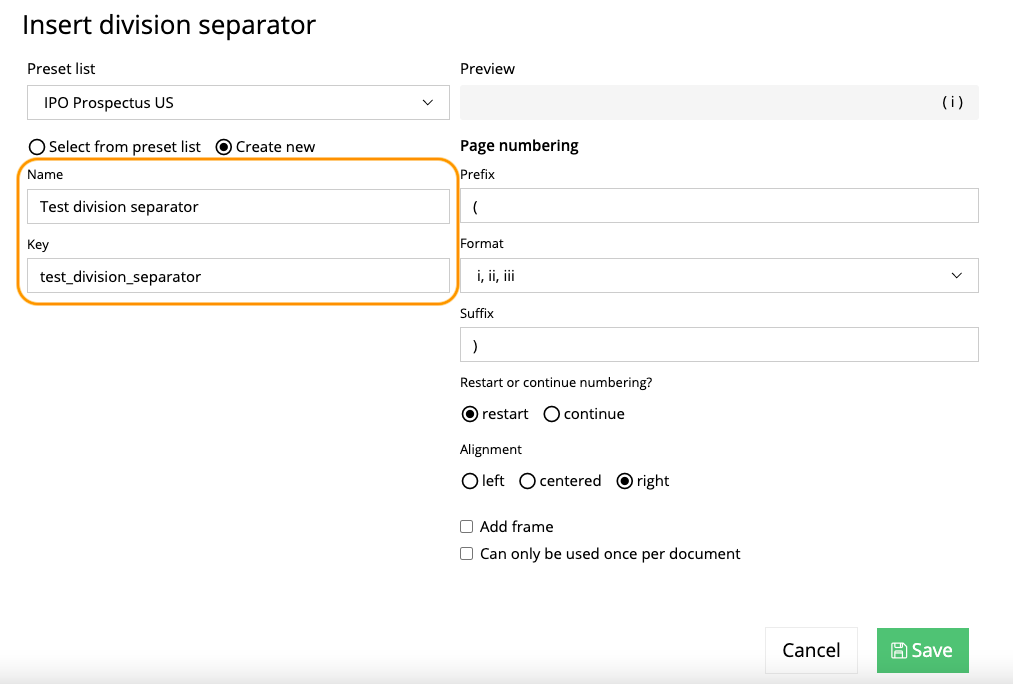
Name and key of a new division separator
6Are there any restrictions for name or key of a division separator?
There are some rules for inserting key:
the input is allowed only with small letters, capital letters and underscore;
●underscore symbol must be inserted after each word.
Importing documents
1How can I import a document?
Click on the green plus button at the bottom right of the document view and select "Import MS Word document". In a dialogue window you can now either insert a document by Drag & Drop or search on your PC for it. In the second step you can decide how the formatting should be taken over in SMASHDOCs. In the third and last step, edit the metadata of your document and click on "Create document". Your MS Word document is imported and displayed as a draft document in the document list.
Please note that SMASHDOCs only supports the import of.docx files. Files in.doc format cannot be uploaded.
2What types of files can I import?
Currently you can import documents in .docx format and in .sdox format in SMASHDOCs.
3Can I import a Word file into SMASHDOCs?
Of course, you can import Word files into SMASHDOCs. Moreover, you can also decide which SMASHDOCs paragraph styles will be linked to Word styles in the current document.
4Why are some Word files imported immediately in Review mode?
There are some cases when a Word document is imported immediately in Review mode:
●there are comments in the imported document
●tracking changes have already been activated in Ms Word
You can add more users to a document in Review mode. You can access the invitation dialogue via "Document options" and there via the "Invite user" submenu.
5Why can I only import documents as .docx?
It has a technical background. Docx is the standard format from the MS Word version of 2007 and thus simply more up-to-date. It is also much more space-saving and faster than the doc format because it stores the layout in XML and CSS files. Therefore, you can only import the current .docx version into SMASHDOCs.
6Why does the import of the Word document not work?
There could be two reasons:
●It is not a".docx" formatted document.
●Your document holds content or formats that (still) prevent import. Unfortunately, everything is possible in MS Word that in a few cases can lead to an import failure.
In this case, simply create a support ticket via https://support.smashdocs.net/en and send us the Word document that cannot be imported. We will be happy to analyze them for errors and correct them, if possible, so that you can import your document in the future.
Every error reported to us helps us to further improve the import!
7Are SDOX templates for import similar for all systems or can be customized upon the requests?
SDOX templates are configured through the AdminUI page by SMASHDOCs Professional Services Team, and they are always customized according to users' requests.
8What should I do if I do not want to import my document into an SDOX template?
In this case you have to leave the field for choosing an SDOX template empty.
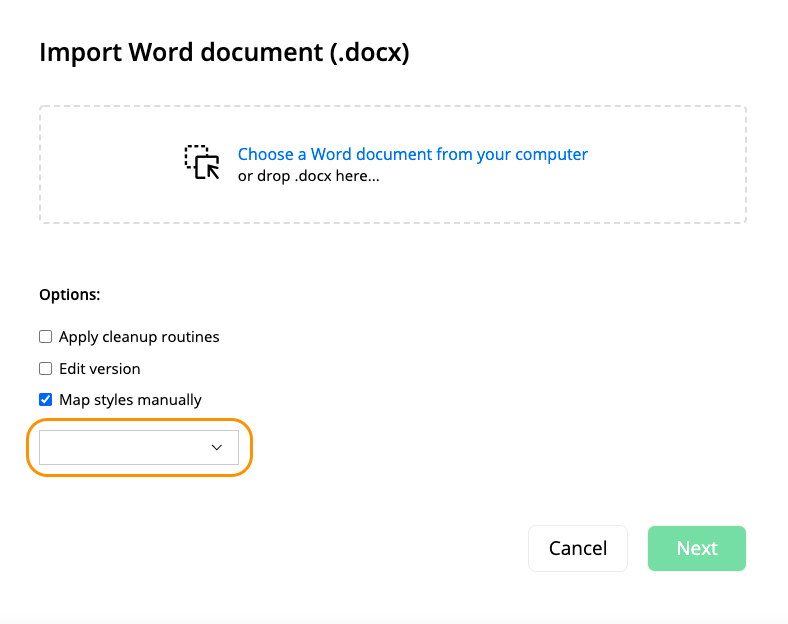
Field for choosing a template
9I have inserted changes in correction mode in one of my Word documents, but now want to import and edit the document in SMASHDOCs. Will the changes and their history also be applied?
The import of change processes of Word documents is currently not possible - but we are working on it! So only the text of your document is imported, the insertion of changes and their recording is much easier with SMASHDOCs anyway ;-)
Images
1How can I insert images?
Images can be easily inserted in two different ways. Either you insert a new image component into your document by clicking on the "Insert image" button in the formatting bar, or you Drag and Drop the image directly to the desired position in the document. A dialogue box opens, in which you can now assign a caption and numbering. After saving, the image is inserted. With the two blue arrows in the lower right corner of the picture you can finally adjust the size.
2How can I replace images?
After clicking on the picture, a context menu with the tab "Update picture" opens. Click on this tab to open a dialogue window. You can also simply double-click on the image to bring up the dialogue box. You can select the new image from your PC or simply Drag and Drop it. The image is updated by clicking on "Save".
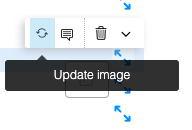
Tab "Update image" highlighted on the top right margin of the component
You can also change the image in the opened context menu and by selecting corresponding option.
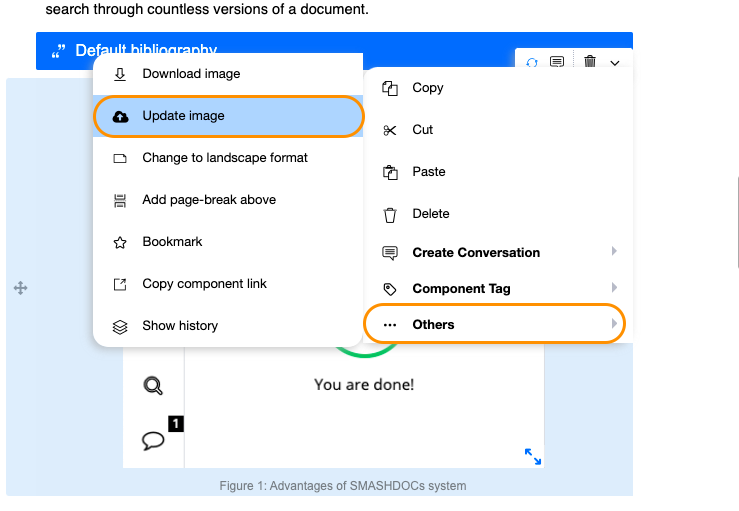
Option "Update image" in the context menu
3How can I view previous versions of the image?
To view the previous version of an image, you can open the tab "Component history". Click on the small number to the right of the component. A column on the right opens and you can view all previous versions of the current image. It also shows which user added which version and when.
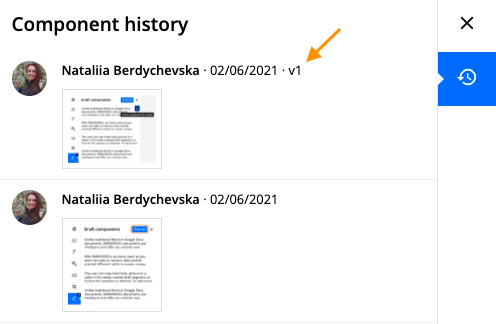
Tab "Component history" highlighted
4How can I create comments for images?
To create a comment for the image, you can click on the image. After clicking a context menu of the picture opens, where you were offered two possibilities to create a comment. You can either immediately select the blue tab "Comment" or "Comment" from the context menu itself. A column for writing comments opens on the right side. Enter your message and decide who can see the comment. A click on "Create" completes the action and the comment is created.
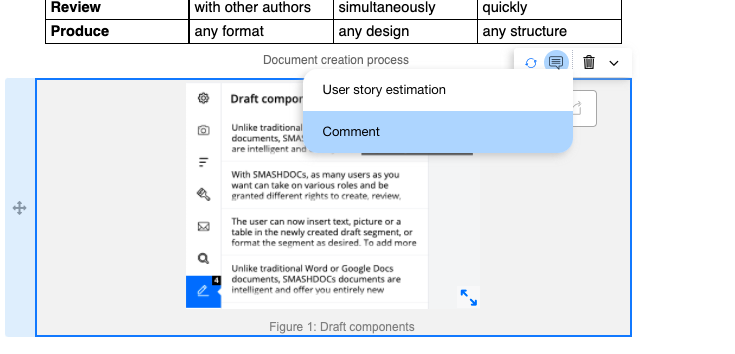
Tab "Comment" highlighted on the top right margin of the component
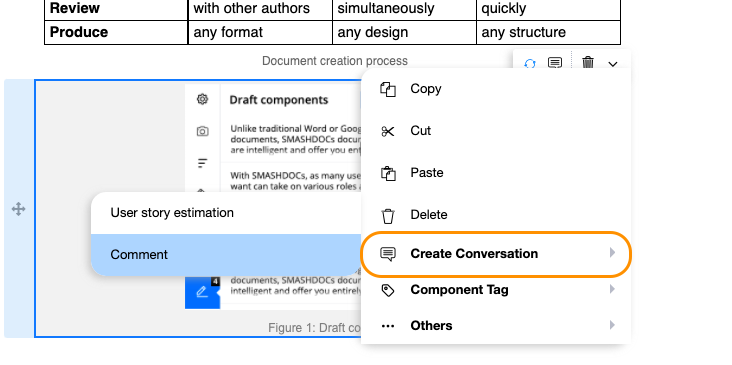
Tab "Comment" in the context menu of the component highlighted
5Why can't I upload an image or replace an existing image?
In this case you do not have the required user role. You can only edit the content of documents in revision mode if you have the role "Suggest" or "Approver".
6Is it possible to save uploaded images in original format?
It is possible to export all original images in the document in their original format. For that you should choose the option to upload all original images in the document as a single Zip file.
Uploading PDF files as images
1I need to upload PDF-file into my document, can I do this?
Yes, you definitely can. For that go to upper toolbar, click "+"-sign and choose here the option "Insert PDF". PDF-files will be converted to PNG-format and will be displayed as images in the editor.
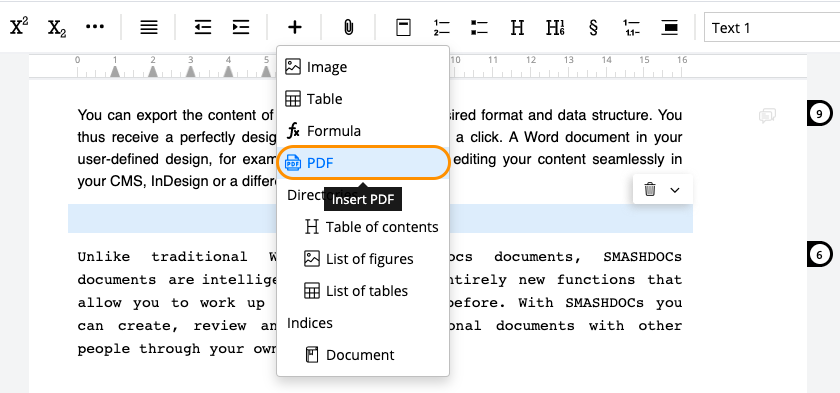
Tab "PDF" highlighted
2How many PDF-files can I add?
You can insert up to 1000 files. The total number of pages, however, should be not more than 1000 pages.
3Which type of content in PDF-file is available for uploading it to the document?
You can upload PDF-files with any type of content (text, images, hyperlinks etc.).
4I received a notification that some of my uploaded PDF files are corrupted, can I proceed importing process with available files?
The importing process can be proceeded only after removing corrupted files. You can do this by clicking a grey cross-sign near the error-sign.
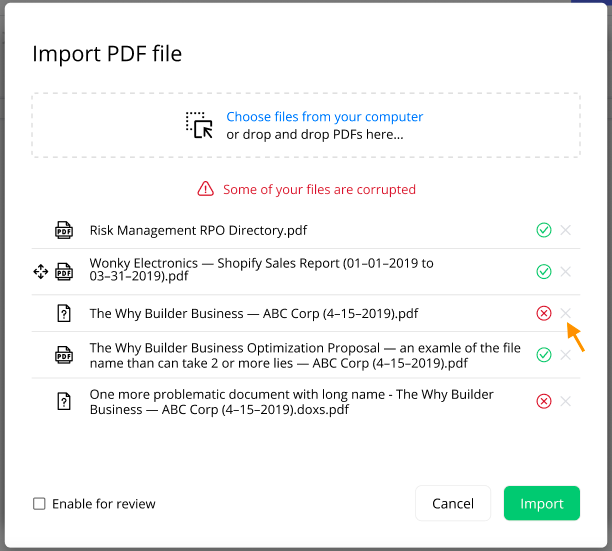
A cross-sign to remove corrupted PDF files from the list
5Will each page of my file be displayed as a separate image?
Yes. Each page will be shown as a separate image without numbering and caption and in 100% width.
6Can I control, whether I add my PDF-files to the document in draft or review mode?
Yes. During inserting PDF-files you will see a special option for that - "Enable for review". If you mark this option, your pages from PDF-files will appear in document in review mode; if you leave this option unmarked - pages will appear in draft mode.
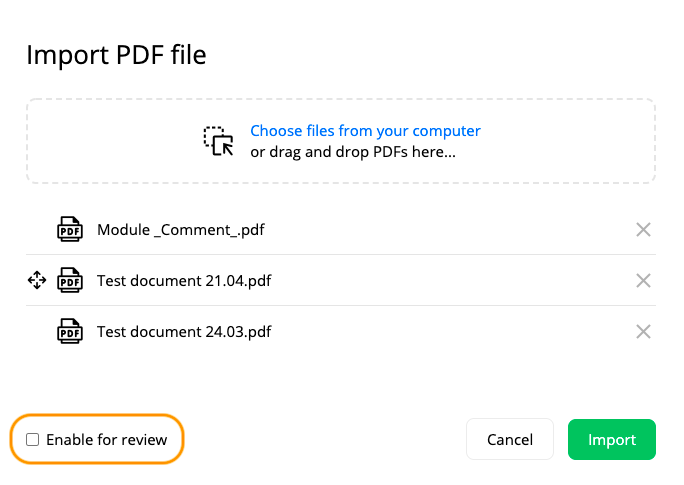
The option "Enable for review" highlighted
7Can I edit imported pages from PDF after uploading?
Yes, after uploading you can edit each page in the same way, as editing images: add numbering, caption, change image etc.
Organising documents
1How can I delete a document?
You can easily move documents to the recycle bin by clicking on the icon to the right of the document name in the document list and selecting "Move to recycle bin" in the context menu. If the document is in the trash, you can restore it just as easily. Open the folder "Recycle Bin" and click on "Restore" in the context menu. Please note that restored documents will end up in the "My Documents" folder and you can move them from there again if you wish.
2How can I create a new folder?
To create a new folder, go to "My Documents". Right-click on "My Documents" and select "Create new folder". In new windows enter the name of the folder and press "Create folder".
The folder is created and appears on the left under the "My Documents" main folder.
The folders in consecutive hierarchy levels can be placed above the respective context menu of a subfolder.
3How can I rename the folder?
Click on the order you want to rename, choose "Edit". A dialogue box opens in which the new name of the folder can be entered. The name will be updated when you click on "Save Folder".
4How to move documents and folders?
There are two ways to move documents and folders. Just Drag and Drop: select the folder or document you want to move and right-click it to drag it to the new location. For folders: if there are already folders at this level, the new folder is automatically inserted into the structure in alphabetical order.
You can also move documents using the context menu. To do this, right-click on the document and select "Move" from the context menu.
After you see a dialogue box with all folders. Click on the folder to move it here. The dialogue box closes and the document is moved.
5How can I delete a folder with documents?
If a folder containing documents is deleted, they are automatically moved to the "My Documents" folder. If the documents are also to be deleted, they must be deleted individually. How this works can be found in FAQ (How can I delete a document?).
6Why can't I delete documents that have been released for editing?
Documents that have been released for processing can be processed by many people. Therefore, even as administrator and creator of the document, it cannot be permanently deleted. Each user can move the document to the trash, but only to his own. He then no longer receives notifications of new changes or comments in the document. All other users can still see the document in their document list and can edit it and coordinate it with each other as usual. This prevents documents and their history from being deleted without authorization.
7How do I know if there are new changes in a document?
As soon as there are new changes in one of your documents, you will receive a notification from SMASHDOCs to your email address. You will only be informed about the affected documents, you have to look at the changes in the document.
In the document list on the left all documents with new unseen changes are also displayed, see the figure below. The red number shows you the number of documents with new unseen changes.
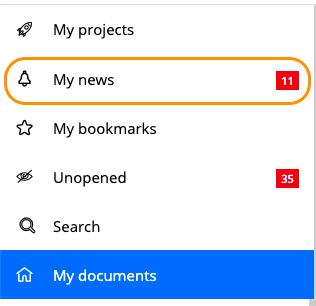
Tab "My news" highlighted in the tab bar
In the document itself, changes to the content are displayed in different colors. In FAQ (What do the different colors and underlays in a document released for editing mean?) we explain to you what these mean. An overview of all changes can also be found in the document on the left in the table bar. How you manage this list is explained in FAQ(How do I mark changes as seen?)
8How can I find out whether there are new conversation contributions in a document?
As soon as there are new conversation contributions in one of your documents, you will receive a notification from SMASHDOCs to your email address. You will only be informed about the documents concerned, you have to look at the contributions in the document.
In the document list, all documents with new unseen changes (including contributions to conversations) are also displayed in the table bar on the left. The red number shows you the number of documents with new unseen changes.
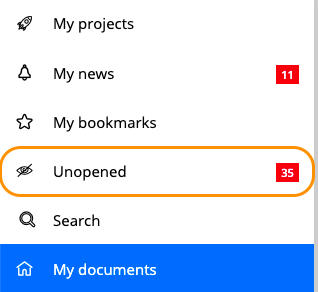
Tab "Unopened" highlighted in the tab bar
In the document itself, the new unseen conversation posts are displayed to the right of the respective component for which a comment has been made. In addition, you have the possibility again to view an overview of all conversation contributions in the table bar on the left.

Tab "Show all document communication" highlighted in the tab bar
Managing users and user roles in documents
1What does "Start Review" mean?
"Start review" means to share your document with other users. During the review process, you invite any number of users to the document and assign different user roles (see FAQ (What are the different user roles?)). Then you can edit your document together with the invited users.
2How do I invite other users to a document?
If you have not yet shared your document with other users, then click on the blue button "Release for revision" in the header of the document. A dialog box opens and you can now enter the names or email addresses of the users with whom you want to edit the document together. Finally, click on "Release for revision" and the users will be invited to your document.
If you have already shared your document with other users, but would like to add more, then click on "Document options" and select "Invite user". Again, a dialogue box will open and you can invite other users to your document by entering their names or email addresses.
You also have the option of composing a message that can be sent together with the standard message about the invitation to collaborate for all users mentioned.
3What are the different user roles?
SMASHDOCs has a total of four different user roles:
●Reader: may only read
●Commentator: may also create or reply to conversations
●Suggest: may additionally add text, images and tables, suggest changes in the document, but may neither decide on it nor delete images or tables
●Approver: may also decide on proposed changes and delete images or tables
In contrast to the additional rights (see FAQ (What are additional rights?)), only one user role can be assigned per user. Furthermore, the assignment and modification of user roles in a document released for editing is only the responsibility of those users who have the additional "Admin" right!
4What are additional rights?
SMASHDOCs have three additional rights that can be assigned in addition to the respective user role:
●Is Admin (can decide on the roles and additional rights of other users)
●Invite (can invite other users to the document)
●Component history (can view the complete history of versions in a document)
●Export (can export documents into any available formats)
●Verisons (can create a version of a document and perform all available options with versions)
●Clean-up routines (can apply clean-up routines in the document)
In contrast to the user role, the number of additional rights per user can be decided. In this way, all three additional rights can also be assigned to a user.
5How many users can I invite to a document?
The number of users you can invite to a document depends on the deployment option you choose. If you have any questions, please contact your system administrator.
6I have invited a user to a document, but I want to undo it. Is that possible?
If you want a user to no longer be able to work on a document, you have the option of deactivating it in the document by unticking the box "Active" in the tab "Manage users".
Please note that only document administrators can deactivate or reactivate users.
Deactivated users are immediately notified automatically by email about the deactivation and then no longer see the document in their document list. If a user has just opened the document while being deactivated, he can no longer work on the document and is informed accordingly on the screen about his deactivation. A deactivated user can no longer find the document via the search or can open it via the document link.
Deactivated users are also deleted from the "Active" list and then only displayed under the "Inactive" list.
If you want to reactivate a deactivated user, simply check the box "Active" again. The reactivated user then appears again in the "Active" list, is automatically notified by e-mail about the reactivation, sees the document again in his document list and can open it again.
7How can I change rights of a user I have invited to my document?
During the user invitation, you can go to the "Rights" tab and only leave the relevant rights activated for the particular invitee. Afterwards, you can change rights through the user management.
8Can I still change the user roles later?
Yes, in "Document Options" under "Options" you will find the "Manage Users" with an overview of all users working on this document. Here you can change the roles of the users.
But beware: You can only assign the role to other users that you have. This means that if you have the role "Suggest", for example, you cannot assign the role "Approver" to other users, since this role has more rights than you have in this case. Furthermore, it is only possible to edit and change the user roles if you have the "Admin" permission, otherwise you cannot access the roles and additional rights.
9I have been invited to a document - where can I see my user role?
If you want to know what user role you have in a document, you can simply see this in "Document Options".
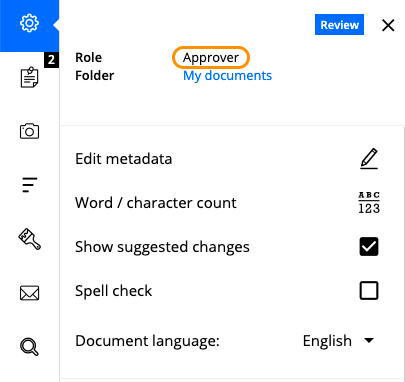
Overview of the user role in a document highlighted
10Can I change my user role in the document?
Yes, although it is only possible if you have the rights of the administrator in the corresponding document. To do this, click on the tab "Show document options" in the table bar on the left and then on "Manage users". The dialogue box opens and you can change your user role.
11Where can I view all users working on a document?
An overview of all users working together on a document can be found in the "User list", which you can call up in the header line of each document under "Show document options". There all users are listed including their roles, additional rights and activity status.
12I have been invited to a document - where can I find the new document?
You will always find a new document in "My Documents". Then you can move it to another folder as you like.
If the new document is still unopened, a notification appears in the left column. This will make it even easier for you to find the new document.
If you are invited to a new document, you will always receive an email. You can then simply click on the inserted link and you will be forwarded directly to the document.
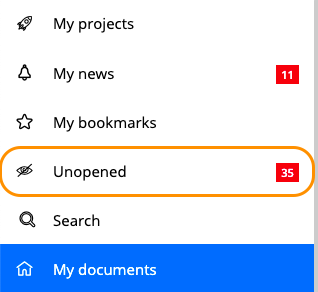
Tab "Unopened" highlighted in the tab bar
13How do I know if someone invited me to a document?
If a user invites you to a document, SMASHDOCs will send a notification to your email address. It will show you who invited you, which document has been released for you and also a link with which you can open the document directly.
You can also find the new document in the document overview "My Documents", see FAQ (Can I change my user role in the document?).
14Why can't other users edit my new components in a document shared for review?
Newly inserted components in a document shared for review are first saved as design components, which you as the creator can only edit. Other users cannot edit the contents of these components.
The only exception: if you are an "Admin" and/or "Approver", you can also share your own design components and those of other users.
Tables
1How can I insert tables?
To insert tables, simply click on the component under which the table should be inserted and select "Insert table" from the formatting bar. A dialogue box opens and you can fill, link and format rows and columns according to your wishes, set the total size and assign a title, which is then displayed as a signature.
You have also a possibility to import finished tables from Excel. However, this is only possible via the dialogue box and not directly in the text.
2How can I edit tables?
Double-clicking on the table opens the dialogue box for editing the table. Enter your changes and click on "Save" to complete the action. Right-click on the table to find more formatting options:
●combining cells
●inserting or removing additional rows and columns
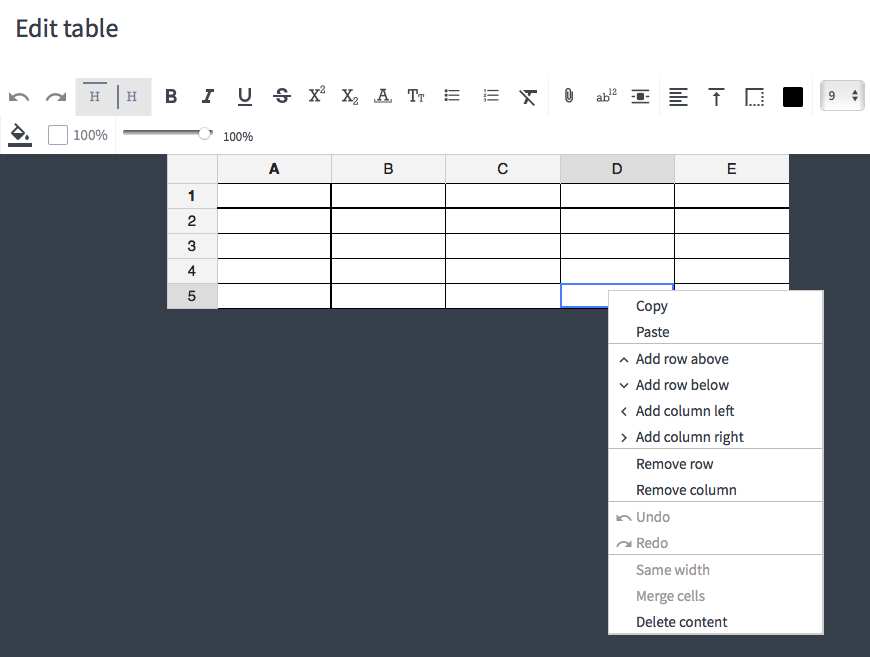
Options for formatting the table highlighted
3How can I view previous versions of a table?
To view the previous version, you must open the component history. Click on the small number next to the component. A dialogue box opens and you can view the previous version of the current table. You will also see who changed what and when. Click on the small number next to the component. A dialogue box opens and you can view the previous version of the current table. You will also see who changed, what and when.
4How can I format tables?
Tables in SMASHDOCs are available in various formatting options. These are displayed at the top of the dialogue box for editing tables. The following options are available:
●Header Row
●Header Column
●Undo / Redo action
●The cell contents are bold, italic, underlined or strike through.
●The cell content left, center, right or as justification
●Vertical alignment of the cell contents at the top, middle or bottom
●Border
●Border colors (applies to all frames in the table)
●Font size
●Background color
●Background intensity
●Table width
Start the edit mode by double-clicking on the table. Select one or more cells and select the desired option in the formatting bar. The content is formatted accordingly.
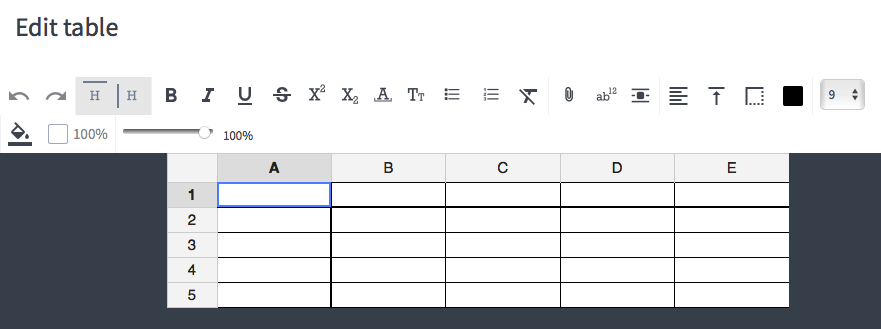
Formatting bar highlighted in the table editor
5How can I add/remove a new row/column?
Open the edit mode by double-clicking on the table. Right-click on the table. Select "Insert rows above/below" from the context menu for new rows. Select "Insert left / right column" from the context menu for new columns. If you plan to delete rows or columns, select "Remove row / column" in the context menu. The action ends with a click on "Save" and the table is updated accordingly.
6How can I combine cells?
Open the edit mode by double-clicking on the table. Select the cells you want to combine. Right click on the table. Select "Merge cells" from the context menu. The action is completed by clicking on "Save" and the table is updated accordingly.
7Why can't I insert or change a table in a document shared for review?
In this case you do not have the required user role. You can only insert and edit tables in documents that are released for revision if you have the role "Suggest" or "Approver".
Financial tables
1Is it possible to edit financial table?
Yes, content of financial table is editable.
2How can I add or remove rows and columns?
If you want to add new row/column, select the existing row/column near which new one should be placed, and right-click it. Two options "Insert" and "Delete will appear and you have to click "Insert".
Note: new rows are inserted only above the existing ones, new columns are added only left from the existing ones.
When you need to remove row/column, select the required one, right-click it and choose "Delete".
3Which settings are available during editing the financial table?
While editing a table, the following settings are available in the opened modal window:
●Alignment (positioning of text in a cell):
●right
●centered
●left
●Merging cells
●Separating cells
●Border type
●none
●single bottom
●double bottom
●Cell styles
●standard
●header
●Currency
●dollar
●euro
●Percent
●Leader column
4Is it obligatory to insert both table name and table caption?
No, these two fields are optional, and you can save the table even without inserting table name or table caption.
5What is the difference between table caption and table name?
Table caption is displayed under the respective table in the editor, table name is displayed as a name of this table when you export it in Excel.
6Where can I find information about changes made in financial table?
Changes in financial table are tracked in table history, in unseen table view and comparison report.
7Can I approve or decline changes made by other users?
No. Changes in financial table are instant-approved and cannot be accepted or rejected.
8Is it possible to apply formulas to perform counting operations in the table editor?
Yes, this option is also available. For that you have to set a table cell as numeric (to set the cell as currency or percentage cell) and then perform counting operations with formulas in the same way, as in Excel.

Summing operation displayed
9Are all formulas from Excel available in the table editor?
Yes, like in Excel you can perform counting operations applying any formula.
10Can I re-import Excel tables, if after exporting to Excel I've made some changes in tables?
Yes, you can re-import such tables and also follow the chages in the table history in the editor then. For that you need to select the option "Update via an Excel file (.xlsx)" in the opened context menu, after you've clicked on the corresponding table.
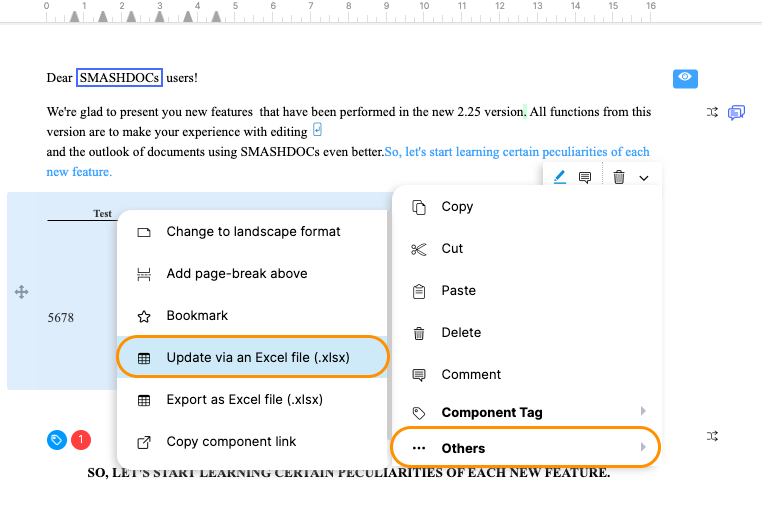
The option "Update via an Excel table (.xlsx)" marked
11Is it possible to re-import tables from Excel if I changed table name and range inside the exported spearsheet?
Yes, this is possible, as well.
Footnotes
1How can I insert footnotes?
To insert a footnote, simply click where you want to insert the footnote in the document and then click the "Add footnote" button in the formatting bar. The dialogue box opens where you can write the contents of the footnote. All footnotes are automatically numbered consecutively.
To find a footnote quickly, you can select the tab "Show table of contents" in the table bar on the left and then "Footnotes". All footnotes are listed, but you can also search for a footnote. After clicking on a footnote, the corresponding component will be highlighted.
2Where can I find the icon for footnotes?
The icon appears in the component history of a leading component (component, which an inserted footnote refers to).
3When will an icon for inserted footnotes appear?
As soon as you add a footnote to the component.
4Does a single footnote icon appear for all footnotes in a leading component?
No, for each footnote there is a separate icon. Therefore, if you have more than one footnote to a single leading section, there will appear corresponding number of icons in the component history.
5Why can't I insert a footnote or edit an existing footnote in a document shared for review?
In this case, you do not have the required user role. You can only insert and edit footnotes in documents that are released for revision if you have the role "Suggest" or "Approver".
6How do I delete footnotes?
You can either select a footnote in the table of contents or click on a footnote in the text. There you will see the context menu and a corresponding button to delete footnote component.

Button to delete footnote highlighted
Web links
1How can I insert web links?
To insert a web link, click on the point in the document where you want to insert the web link and then click on the "Weblink" button in the formatting bar. A dialogue box opens and you can now enter the URL and the display of the link in the document. Alternatively, you can simply select one or more words and then insert the web link. The display of the link in the text then corresponds to your selection. After clicking on "Save" the text is updated accordingly. You can see the list of all web links in the table bar on the left under the tab "Table of contents".
Please note that web links can only be inserted in the text and not in headlines.
2How can I edit web links?
You can either select a web link in the table of contents or click on a web link in the text. To edit the web link, click on it. The dialogue box opens where you can select the "Edit" tab.
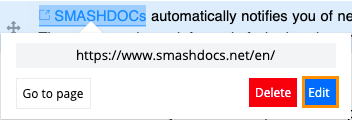
Tab "Edit weblink" highlighted
3How can I delete web links?
You can either select a web link in the table of contents or click on a web link in the text. To delete the web link, click on it. The dialogue box opens where you can select the "Delete" tab.
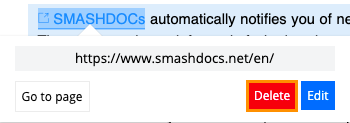
Tab "Delete weblink" highlighted
4Why can't I insert a web link or edit an existing web link in a document shared for review?
In this case you do not have the required role. You can only place and edit web links in documents that are released for revision if you have the role "Suggest" or "Approver".
Comments
1How can I create comments?
Please note that you should at least have the role of "Commentator" to create comments.
Click on the component or select individual words where you want to add a comment. In both cases, select the tab "Comment" in the context menu at the top right of the corresponding component. The dialogue box opens to the right of that component. Enter your comment or subject, main comment and decide who can see it. Your comment can be visible to everyone, to selected people or just to you.
In addition, you can also set whether your comment is done immediately or the decision has already been made and no dialogue is required or will have the unresolved (pending) status.
2Are both fields "Topic" and "Main comment" obligatory to fill in?
No. The obligatory field is "Main comment", "Topic" is optional.
3Can I delete comments?
You can delete a comment if it's a private one or no one has seen it before.
4Who can see comments?
Please note that only users already invited to the document can see comments.
Who can see comments depending on your settings. The default setting allows all users see your newly created comments. Nevertheless, you can also determine who is allowed to see your comments: only you, all users in the document or only selected users.
You can also invite other users later or delete users from the dialogues.
5How do other users know that I have made a comment?
Other users will be informed about your new comment in various ways:
●they will receive an email with the information that there are news (new comment) in the document
●document appears in their document list under "My News" with the new comment
●new message about your comment appears under the tab "Show all open changes of the document" in the table bar link in the open document
●a small red dialogue symbol about new comment appears to the right of the component

A small red dialog symbol about the new comment in the document highlighted
6How do I see comments from other users?
●you will receive an email informing you that there are news (new comment) in the document
●document appears in your document list under "My News" with the new comment
●new message about the comment appears under the tab "Show all open changes of the document" in the table bar link in your document
●a small red dialogue symbol about new comment appears to the right of the component
7If I have a long comment list, how not to lose the first comment I opened?
When you open a particular comment in detail and then go back to the general comment list, the comment you started with will be highlighted.
8For how many users can I assign a comment?
You can assign comments for as many users in the document, as you need.
9Can I assign a comment for several users via mentioning them with @-sign in the field "Main comment"?
Yes, you can mention more than one user with @-sign.
10Where can I change assignees?
To do that you should open the comment and move to the tab "Contributors".
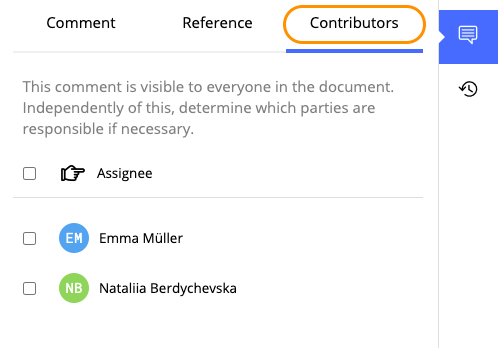
Tab "Contributors" highlighted
11Is it obligatory to set due date after assigning a comment?
No, you can assign your comment without setting due date.
12What does the option "Stop notifying me about news" mean?
If you select this option, you will not be informed about updates in this comment and you will not receive notifications via email about these changes.
13Is the option "Stop notifying me about news" applicable per one comment?
Yes, if you have several comments and you do not want to be informed about updates in all of them, you should select this option in each comment.
14Where can I find filters by comments assigned for particular users and unassigned comments?
To find these filters you should open the tab "Conversations" in the left toolbar. Here, above the first comment in the list the "Select assignees" and "Unassigned" filters are placed.
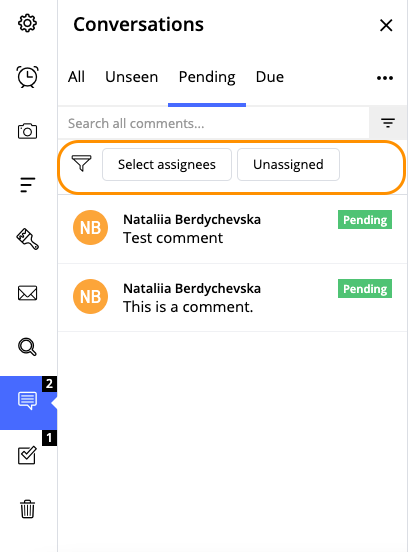
Filters "Select assignees" and "Unassigned" highlighted
15What happens, if I select an assignee and click "Go"?
After that, all names of selected assignees will be displayed and all comments assigned to these users will appear in the list.
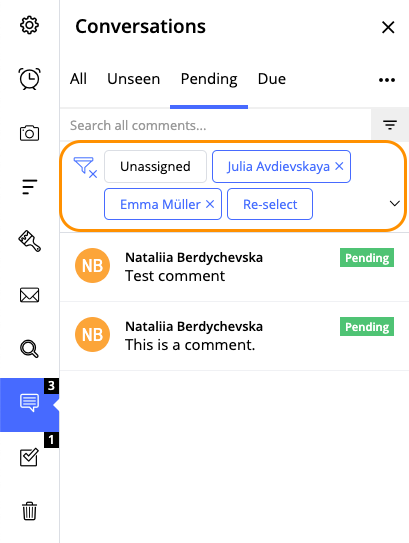
Names of selected assignees displayed in a blue frame
16Which comments are displayed in the list, if I select all users?
In case you select all users and click "Go", all comments, including unassigned, will be displayed in the list.
17Which comments are placed under the tab "Due"?
Tab "Due" shows comments which are overdue and assigned for current date (today).
18How can I export comments to Word?
To be able to export comments during the exporting document to Word you should mark comments as visible in export. You can do this either during comment creation or later, after a comment has been created. During creating comment you can find this option under the field "Main comment". In the field "Visible in export" choose "Available".
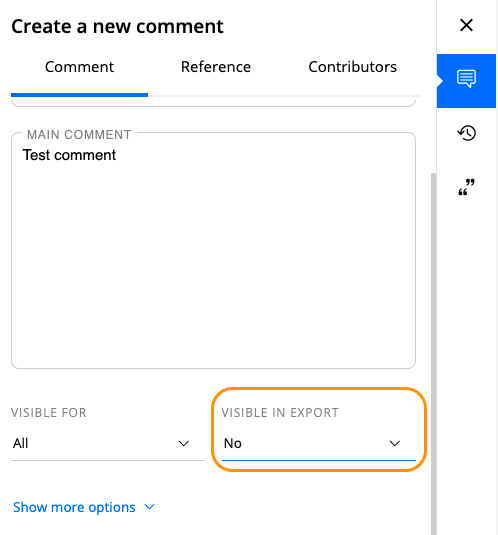
Comment setting "Visible in export"
If you have decided to mark comments visible in export after creating, you have to open the comment you want to export, then open the tab "Metadata" and there, below comment settings tick the checkbox "Visible in export".
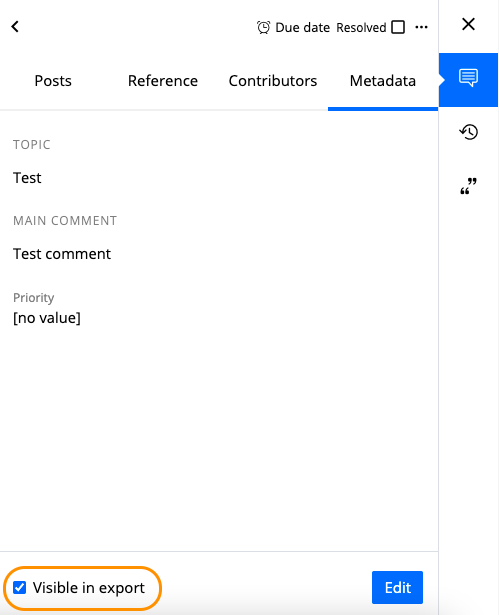
The option "Visible in export" in comment metadata
After marking comments as visible in export, do not forget to activate the option "Export comments" in the export dialog window.
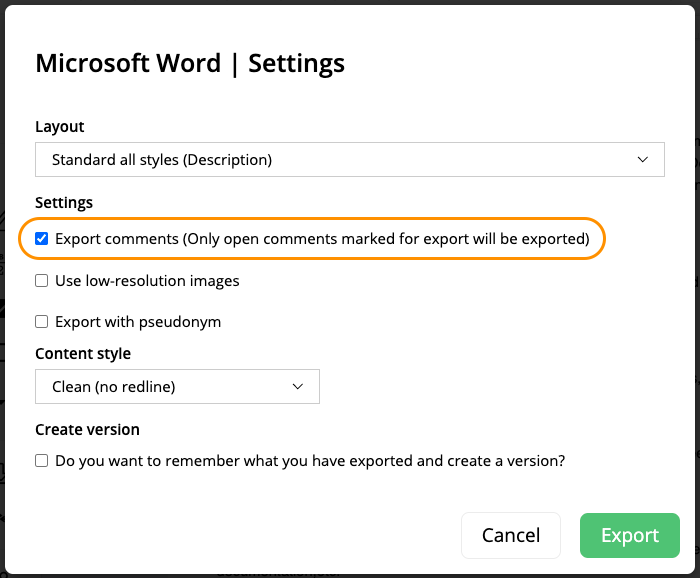
The option "Export comments" in the export dialog window
19Do I have to mark each comment that I need to export as visible in export?
Yes, for each such comment you should tick this option separately.
20Where can I find the lists of comments that are visible for export and resolved comments?
These tabs are hidden under three dots near the tabs "All", "Unseen", "Pending" and "Due".
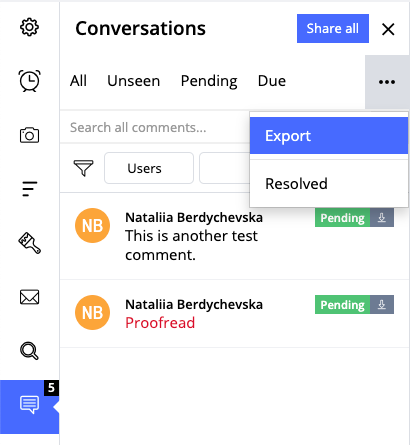
Tabs "Export" and "Resolved"
21How can I add a comment to a certain text of a component?
For that you have to select corresponding text in a component and in the context menu select an option "Create comment". In the tab "Reference" selected text will be displayed highlighted in yellow.
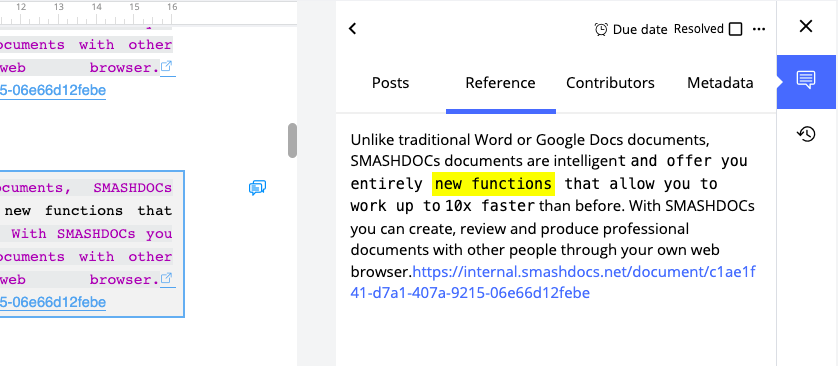
Selected text in a component that is referenced for a new comment
22I would like to send a comment only to certain users - is that possible?
Yes, by selecting only the users who should see the comment.
You can also add more users later by clicking on the plus sign at the bottom of the opened conversation and entering the names of the users you want to add in the dialogue box that opens, see the following figure.
In addition to individual users, you can make the entire conversation visible to all users working in the document at the same time. Just select "Visible for all" in the dialog window.
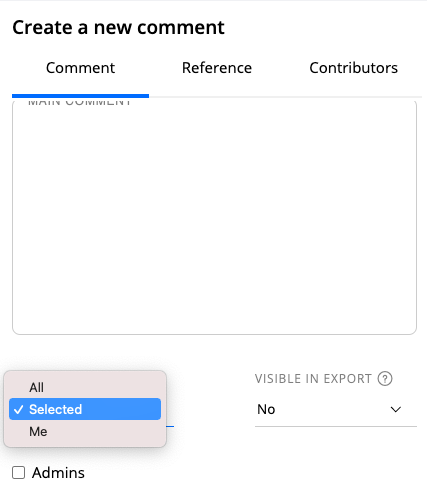
Creating comment for selected users highlighted
23Is it possible to send the link of a comment?
Yes, it is. For that you need to open the required comment, click on the link-sign at the top right corner and you will be able to copy URL of the comment. Then you can send it to other users or open it in a new tab.
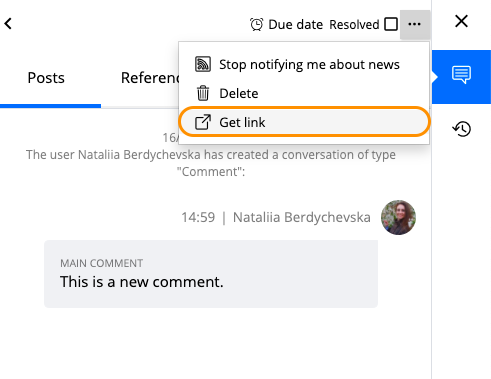
Link-sign to copy URL of a comment
Note: to open the comment link users must have the access to the corresponding document and have the required role to be able to read comments. Also, comment must be visible for these users.
24What is the type of comment "Alternative text" is used for?
This type of comment is preferably applied for images. The main idea of this comment is to describe content of a picture, as well as written objects inside a picture in words. This helps to avoid barriers in peception of the visual information.
25What should be inserted in fields "Alternative text" and "Image caption"?
Field "Alternative text" represents detailed content description of an image, in the field "Image caption" all written objects inside the picture should be inserted.
Announcements
1Can I write an email to all/selected users from SMASHDOCs?
Yes, if you click on the tab "Compose an announcement" in the table bar on the left of the open document. The dialogue box opens where you can compose your message. Then choose who should receive them. For "Selected" check in the field next to each user. If you want to send the message to all users, select "All" in the dialog box.
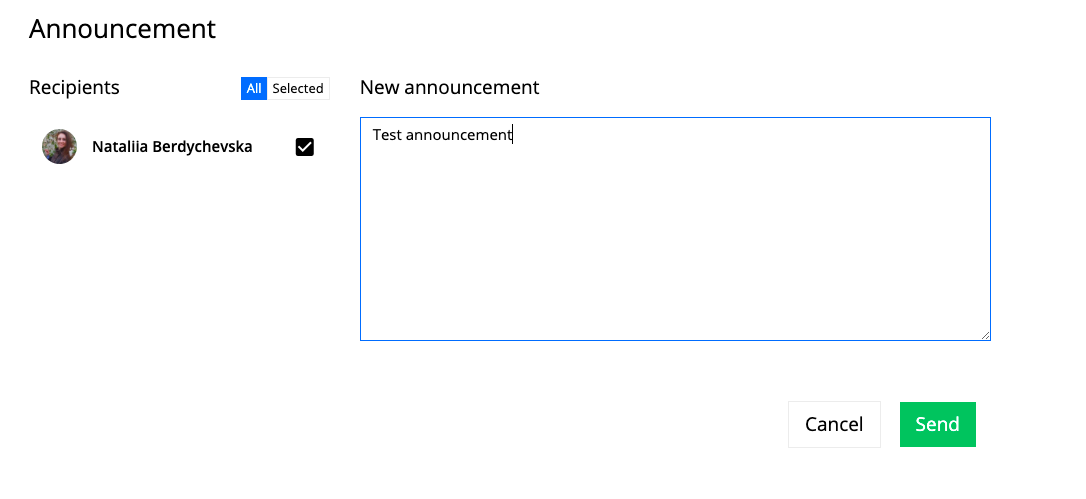
Dialogue for creating an announcement highlighted
2What is an announcement?
An announcement is a message that you can send via email to all or selected users from SMASHDOCs.
The email sent contains the name of the document and a direct link to open it so that users know immediately which document you are writing about.
3How do I write an announcement?
Click on the envelope icon or the tab "Compose an announcement" in the table bar on the left side of the opened document. The dialog box opens and you can compose your message. For "Selected" check in the field next to each user. If you want to send the message to all users, select "All" in the dialog box.
Cross-references
1What is a cross-reference?
A cross-reference is a link from one component of the text to another component. The component here also means a numbered heading, an image or a table.
2How can I insert cross-references?
To do this, click on any point in the component in which you want to insert the cross-reference and then in the formatting bar on the button "Cross-reference". A window will open where you can select the component you want to link to.
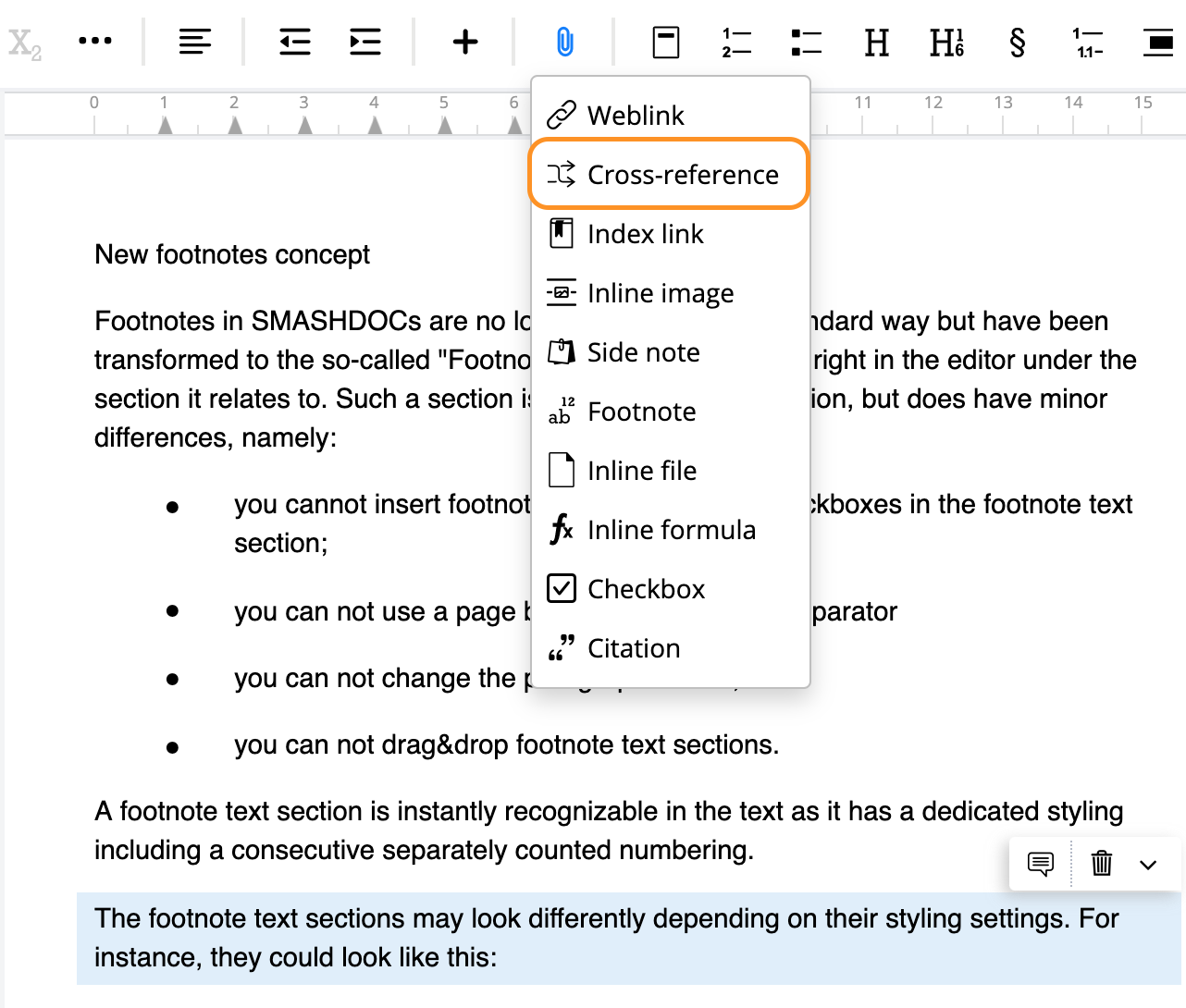
Button for inserting a cross-reference highlighted in the formatting bar
After inserting the cross-reference, a small symbol appears to the right of the component in which the cross-reference was inserted, which shows you an overview of all the cross-references available in the component with one click.
3How can I refer to a component in the document?
Click on the place in the text where you want to add a cross-reference and then on the "Cross-reference" button in the formatting bar. In the opened dialog box you can choose between figures, tables, signatures, numbered headings. In addition, all possible cross-references are listed in the tab "All".
After inserting a cross-reference, a small icon appears to the right of the component where the cross-reference was added. Click on this and all cross-references for this component are listed in detail in the opened dialog box. Not only cross-references of the corresponding component are listed, but also components to which reference was made.
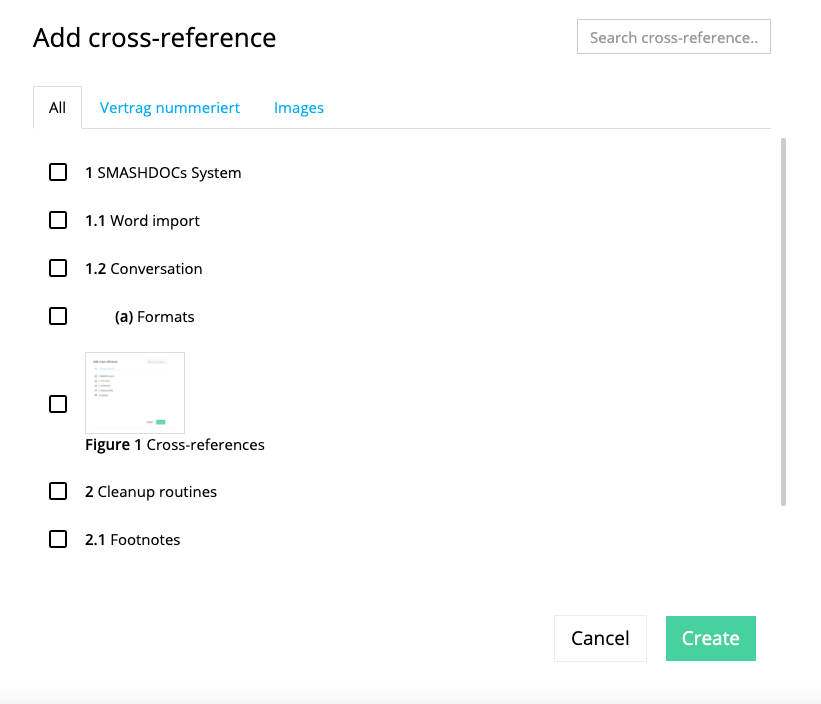
Tab "Add cross-reference" highlighted
4Is there a special list of paragraph styles which I can create cross-references to?
Basically the main reference targets are the following:
●Headings
●Numbered headings
●Numbered text components (without heading attributes)
●Footnotes
However, paragraph styles that can be applied as cross-references are configurable per system, according to customer requests.
5Can I refer only to text components?
No, you can also create a cross-reference to images, tables, footnotes and page number.
6How can I change a cross-reference?
In the text, click the cross-reference you want to change. The dialog box opens, where the option "Edit" will be displayed. In the opened modal window you have to select a reference target to replace the previous one. After you have finished with the changes, save them and the text will be updated accordingly. You can choose only one target while editing a cross-reference.
Please note that you can only edit cross-references if you are the "Suggest" or "Approver".
7If I need cross-reference to be displayed not as numbering, but as content, how can I change this display?
You have to open cross-reference menu and below you'll see display settings.
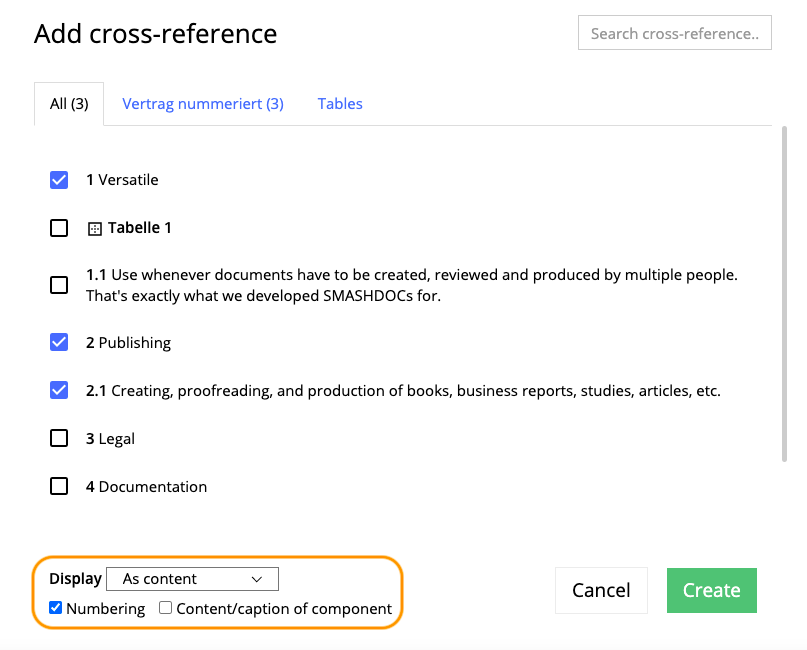
Cross-reference display settings
In the setting "Display" you can see two options "As content" and "As page number". If you choose the variant "As content", two additional settings "Numbering" and "Content/caption of component" are available. There you can decide, whether cross-reference should have an outlook of numbering, of content/caption or both.
In case you select "As page number", those two additional options will not be displayed.
Note: when you refer to footnotes, in this case references can be displayed only as numbering.
8How can I differentiate whether cross-reference has been created to a numbered heading or to page number?
In the text of a document there are different symbols to display reference targets. Numbered headings are displayed with a number, cross-references "As page number" have a special sign.
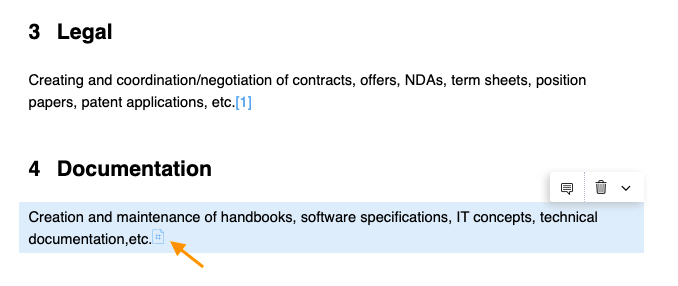
Display of a cross-reference with the set outlook "As page number"
In the exported Word document this sign will be transformed into a corresponding page number.
9Are changes in cross-references tracked?
Yes, you can follow changes in cross-references in the component history of a corresponding component. These changes can be also accepted or rejected.
10Can changes in cross-references be tracked in text components only?
No, along with text components changes in cross-references are also tracked in footnote and table components. In side notes cross-references are not tracked.
11How can I delete a cross-reference?
In the text, click on the cross-reference you want to delete. The dialog box opens where you can select the "Delete" tab. Then the cross-reference disappears from the corresponding component.
Please note that you can only delete cross-references if you have the role of "Suggest" or "Approver".
12Can I copy and paste cross-references?
Yes, you can. All cross-references will be safe and workable after you transfer them to another SMASHDOC.
13How can I find all components referenced in a component?
To the right of each component that contains a reference, a small icon appears. Clicking on this icon opens a dialog box with detailed cross-references.
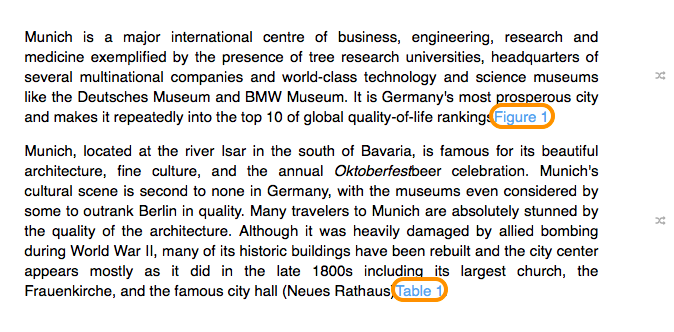
Cross-reference icons highlighted in the document
14How do I find the component that was referenced?
In the text, click on any cross-reference. The dialog box opens, where you can click on the tab "Go to". After this click, you will be shown the component referred to.
15How do I know that a component has been referenced by the other component?
In this case, a small icon appears to the right of the cross-reference component. Click on it and all cross-references are listed in detail in the dialog box.
16Are cross-references automatically renumbered when I change the numbering in my document?
Yes, cross-references are not only numbered consecutively, but also adapted to document changes in numbering.
17How can I see if a cross-reference is no longer valid?
As soon as there is a broken cross-reference in the document, the tab with the exclamation mark appears in the table bar on the left. A hint "broken cross-reference" is also shown in the component itself.
When you click on the exclamation point, SMASHDOCs shows you the list of all broken cross-references.
Click on a broken cross-reference to highlight the corresponding component in the document. You can either edit or reset a broken cross-reference or delete it. Both solve the problem.
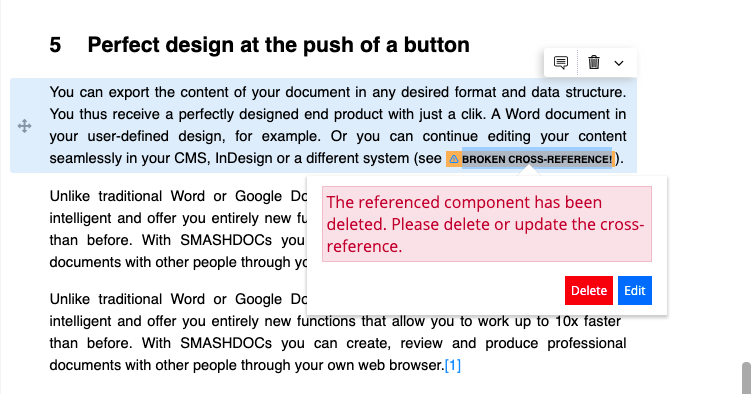
Broken cross-reference highlighted in the document
18How are cross-references displayed in the document?
Cross-references can be displayed either as numbering or as content/caption of component (depending on which outlook has been chosen during the adding a cross-reference).
19Can I insert several cross-references at once?
Yes, you can select several reference targets, while adding a cross-reference. For that, you should tick corresponding checkboxes.
20Will the selected reference targets be displayed in a document as a single cross-reference or separately?
All reference targets are displayed in the document as separate cross-references.
21Can I export the cross-references to Word?
Yes, you definitely can. The cross-references are exported to Word in the same manner as any other components. You don't have to do any additional set-up, just proceed with the export of a needed document and you're good to go. You'll see the cross-references in the exported document right where they're supposed to be.
Bookmarks
1How can I bookmark the component?
Click on the component where you want to bookmark. Select "Bookmark" from the context menu. A small red star appears to the left of the component, which you can use to immediately recognize a bookmark.
A small star symbol also appears in the table bar on the left. The grey counter with the number shows how many bookmarks you have in the document.
Click this icon to view an overview of all bookmarks in the document. Clicking on a bookmark in this list will take you directly to that component.
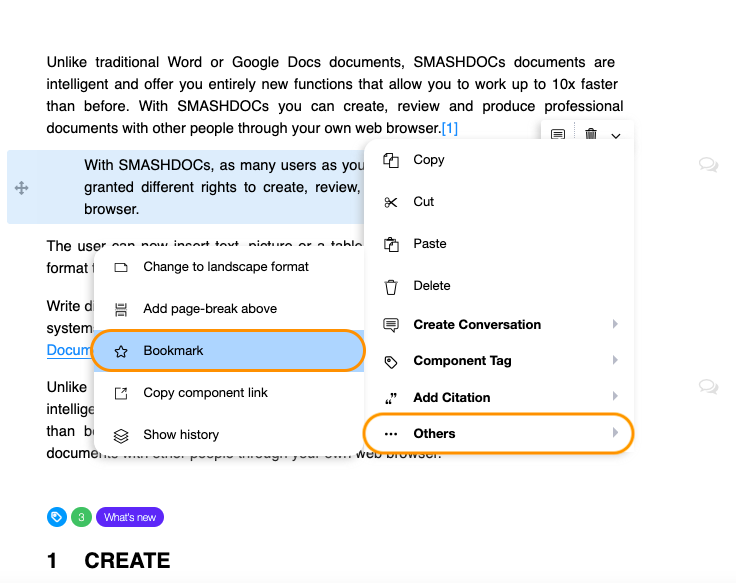
Inserting the bookmark highlighted in the context menu
2What is a bookmark for the component?
A bookmark is a form of the component mark so that you can quickly find it again.
3Why do I need a bookmark for the component?
You can mark a component with the bookmark to make search of particular information much easier.
Component tags
1What is a component tag and why is it needed?
Component tags is a specific marker type used in SMASHDOCs for the selective highlighting of information. Tagged components create the guidelines for searching specific data in the document later on. You can find more information about component tags, their categories and functions here https://service-description.smashdocs.net/component-tags.
2Which components can I mark with a component tag?
You can assign a component tag to text, images, formulas and table components.
3Is there an opportunity to search a component tag in the directory?
If the "Component Tags" module is enabled in the system, you can easily search a required component tag using the option 'Show directories' in the left panel. Do not forget to choose "component tags" from the dropdown menu under the three dots icon.
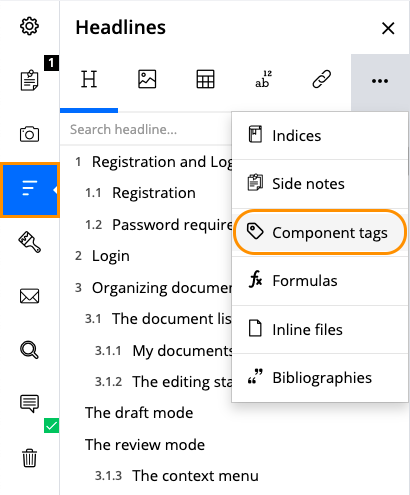
"Show directories" and "Component tags" buttons highlighted
Table of contents
1Can I create a table of contents in SMASHDOCs?
We have great news for you: Tables of contents are created automatically by SMASHDOCs!
For all images, tables, headings (including numbered headings), footnotes and web links, a corresponding directory is created and updated accordingly when changes are made. You can view the tables of contents in the table bar on the left.
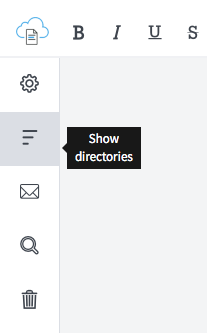
Tab "Show directories" highlighted in the tab bar
2How can I create a table of contents?
A table of contents is automatically created for you by SMASHDOCs.
A list is created for all the figures, tables, indexes (including numbered indexes), footnotes and web links and is adapted accordingly if there are changes.
3Where can I find the table of contents?
A table of contents can be found in the table bar on the left. You will also find the lists with figures, tables, footnotes and weblinks.
4How can I export a table of contents?
A table of contents is always automatically exported in HTML format.
In Word Export you can still choose which lists should be exported with it.
5How can I set multiple/fewer levels in the table of contents?
In the table bar on the left, click on the tab "Show the table of contents". In the right margin of the list you will find a small drop-down menu for setting the layers. You can choose here until which level the table of contents should be shown.
6How can I influence the display of different lists?
Since SMASHDOC automatically creates the table of contents, the corresponding list is adapted each time you insert:
●a new index (regardless of whether it is numbered)
●a new image
●a new table
●a new footnote or
●a new weblink
7List of images
SMASHDOCs automatically creates a list of images when you insert an image.
Just as with the table of contents, you can call it up in the table bar on the left under the tab "Show the table of contents". Clicking on a character in the list will take you directly to the corresponding component of the document. The figures are listed in chronological order.
8List of tables
SMASHDOCs automatically creates a list of tables when you insert a table.
Just as with the table of contents, you can call it up in the table bar on the left under the tab "Show the table of contents". Clicking on a table in the list will take you directly to the corresponding component of the document. The tables are listed in chronological order.
9List of footnotes
SMASHDOCs automatically creates a list of footnotes when you add a footnote.
Just as with the table of contents, you can call it up in the table bar on the left under the tab "Show the table of contents". Clicking on a footnote in the list will take you directly to the corresponding component of the document. The footnotes are listed in chronological order.
10List of links
SMASHDOCs automatically creates a list of links when you add a link.
Just as with the table of contents, you can call it up in the table bar on the left under the tab "Show the table of contents". Clicking on a link in the list will take you directly to the corresponding component of the document. The links are listed in chronological order.
Comparison report
1Can I compare my documents?
Yes, you can. In the list of document options you can find a function "Compare" and then you need to choose a document for comparison. After that, you will get a comparison report.
2Which documents can I choose for comparison?
You can compare your document with both SDOX and Word documents.
3How many documents can I compare?
More than two documents can be compared.
4Is it obligatory to insert a creator of a compared document?
No, this is an optional function.
5Which information will I receive from the comparison report?
You are able to understand changes to the following types of information:
●Text components
●Images and image captions
●Tables and table captions
●Footnotes
●Weblinks - if the URL is not the same as the label and the URL has been changed
●Comments
●Cross-references
●Side notes
●Index entries
●Change of inline and paragraph styles
●Change of numbering level to a text component
6How can I merge changes?
If the module "Document comparison and Roundtrip" is activated in your system, you will see the corresponding buttons for merging in the comparison report. In this case you are able to merge changes either in several components or in the whole document.
7If I want to merge changes in the whole document, can I firstly have a look, how my document will look like after merging?
Yes, you can. For that you have to choose the corresponding type of view - "Merged in 1".
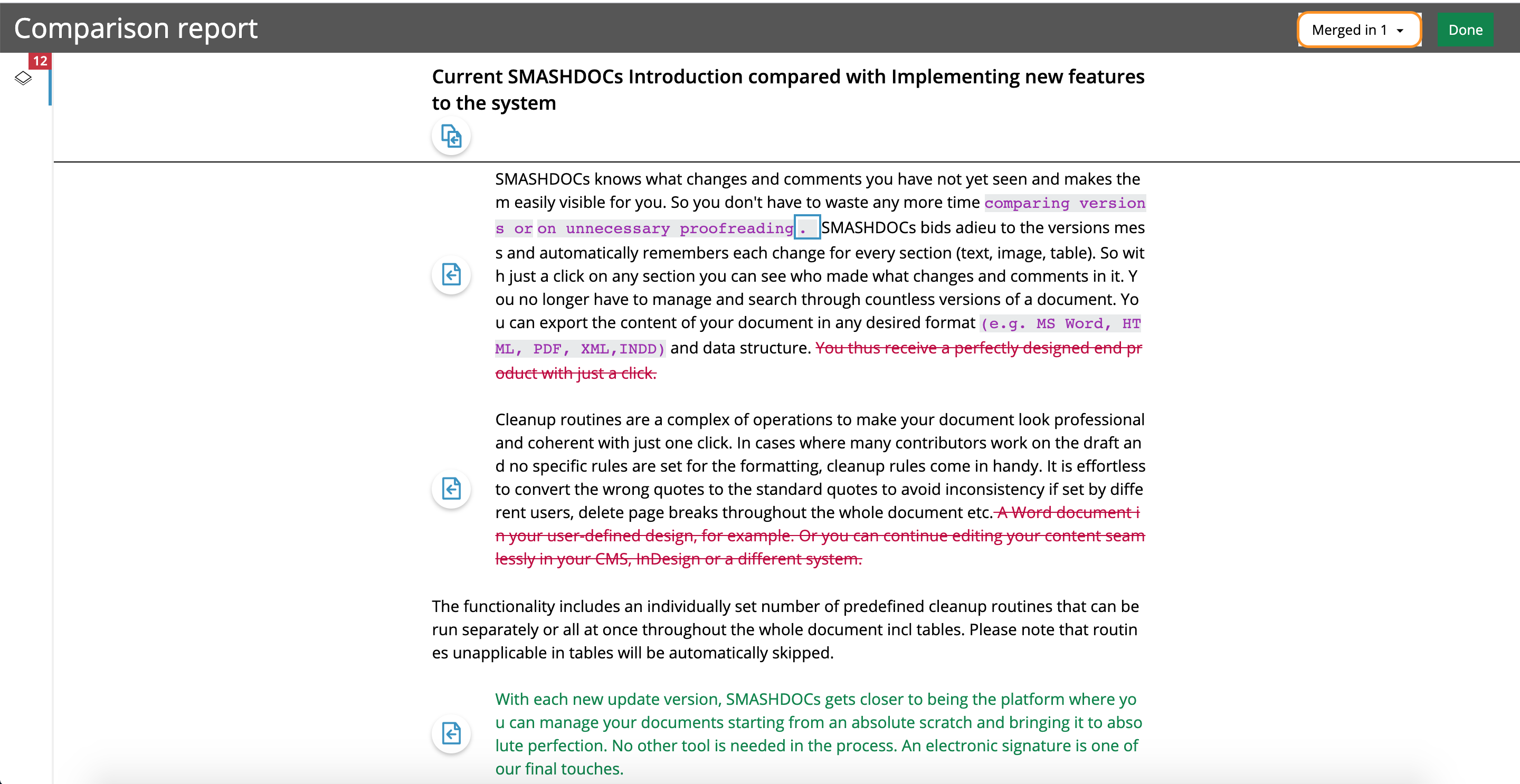
'Merged in 1' type of comparison report view is highlighted
8Are there certain unsupported elements for merging?
Yes, there is the list of unsupported elements during the Roundtrip process. These are the following:
●inline image
●inline file
●side note
●index
●citation link
9Is there such possibility to create a version before merging to remember the chosen document for comparison?
It is possible to do so, if the module "Versions" has been activated in the system. If you have chosen a Word-document for comparison, after clicking "Merge all" there will appear a dialog window to confirm that you would like to create version to remember what has been imported. After that, version will be automatically created.
Exporting documents
1How can I export / print a document?
In the table bar on the left you will find the function "Export" under "Show document options". You can choose to export to a Word file or HTML file. Both formats can then be printed out or converted into a PDF.
In HTML export, a distinction is made between the design and the revision because there are several export options for the revision.
2How can I download exported documents?
As soon as you have clicked the export button, a new "download icon" will appear near your avatar showcasing that the download process has been started. You have to click on the document that you need to download. As soon as there is an ongoing download process, a spinner and a respective message are being displayed near the download icon. The spinner will keep spinning until the download is completed. You can download exported documents within 3 days, after that they will be automatically deleted.
3How can templates for export be personalized?
Personalized templates are part of our premium offer. If you want to know more, click here or drop us a line to info@smashdocs.net. We will contact you as soon as possible.
Word export
1How can I export a document to Word?
In the toolbar on the left, you will find the function "Export" under "Show document options". The dialog box opens where you select Export to Word file.
Before exporting document, you have five main options to perform:
●Сhoose a template for exporting in the line "Layout"
●Decide whether you need to export comments
●Decide whether you need to export images in your document as low-resolution images
●Select content style
●Create version of the exported document, if needed
By clicking on the "Export button", the SMASHDOCs document will be exported to a Word document.
2Which content styles are available for the export to Word?
You're able to choose from 3 content styles when exporting to Word. They are:
●Clean (no redline);
●Redline as currently displayed;
●Redline out of a comparison with a version.
3What does the term "Redline" mean?
Redline is the term that stands for outlook of the document in Word with the unseen or unaccepted by a user changes. In the Word-document you will see this changes highlighted or marked with a line and there will also appear some notes in mark-up area, depending on which changes there are.
4What happens if I export my document to Word with the content style "Clean (no redline)"?
If you choose this content style for your export, your Word-document will have an outlook of a usual black text without any highlights.
5Which outlook will my Word-document have in case I select "Redline as currently displayed"?
In this case, the content in the exported Word-document shows the same redline as it currently looks in SMASHDOCs. The unseen accepted changes will be represented as accepted (black text) and unseen rejected changes will not be included in the Word-document. Unaccepted adding will be highlighted with red color and deleted parts will be marked with the line and noted in the mark-up area.
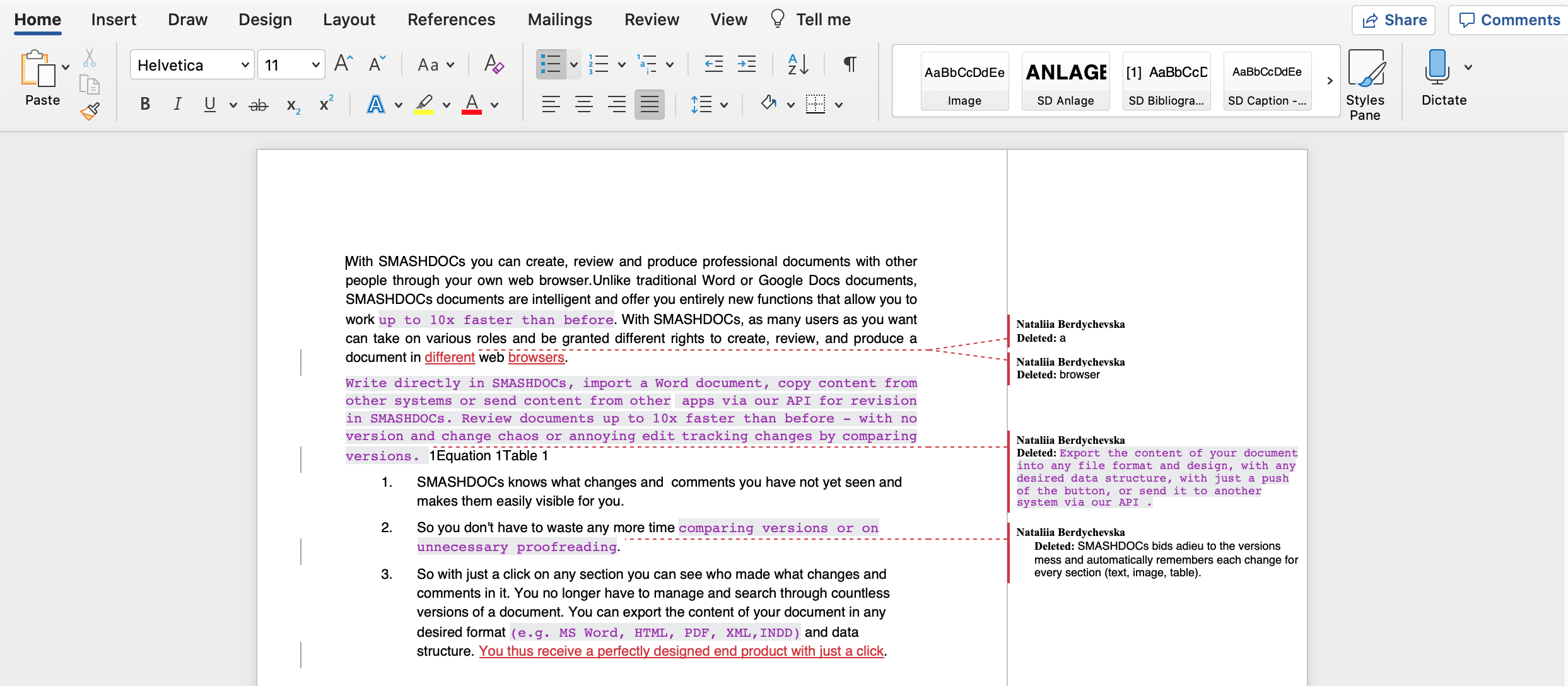
The content style "Redline as currently displayed" in the WORD document
6What does the option "Redline out of a comparison with a version" mean?
With this option you can export your document to Word while simultaneously comparing the actual version to any other version you've saved before (if the module "Versions" has been activated in your system). Then you have to choose the exact version from your list of versions in the additional area which opens to the right. You will see the results of such comparison in the exported Word-document: all changes in text, images, tables and equations will be highlighted with redline in the mark-up area.
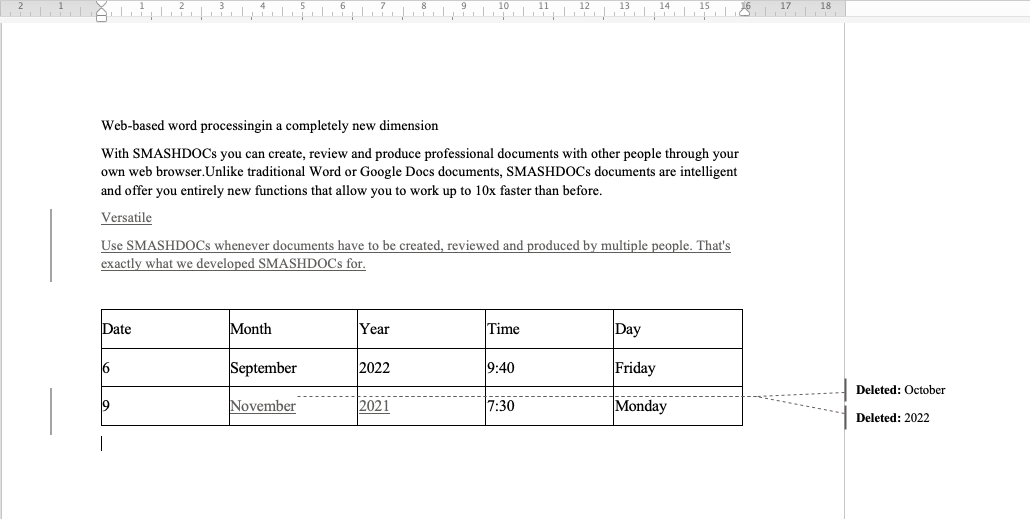
Highlighted changes in the table in Word file exported using the content style "Redline out of a comparison with a version"
7Can I save the exported to Word version in case I'll need it later?
Yes, you can. When exporting to Word, tick the corresponding line "Do you want to remember what you have exported and create a version?". After that, fill in the details such as the name (obligatory), numbering level (sequence number, defined automatically) and note (optional remarks). In the SMASHDOCs editor you will see created version in the list of your versions after exporting.
8How will all inline files be displayed in the exported Word file?
In the Word document inline files are displayed as a clickable link.
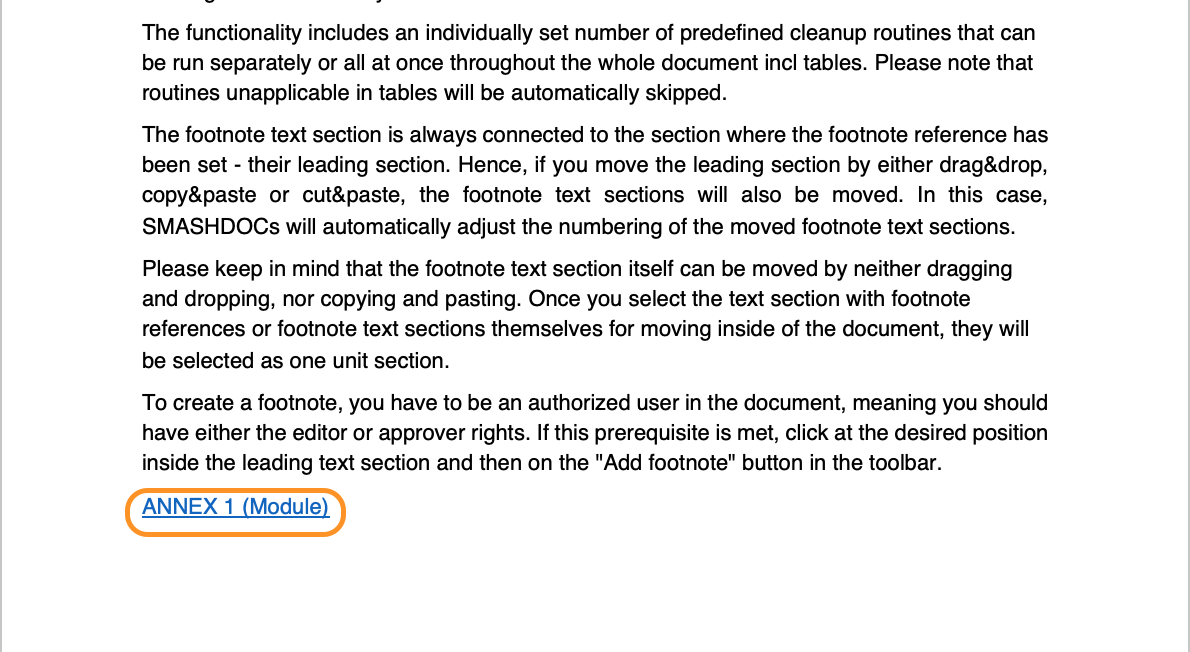
Inline file link is highlighted
You can download file by clicking on this link only if you have access to the document and you are logged in SMASHDOCs account.
9If I cannot reveal the real names of editors of a document, are there any functions to export the document to a Word file properly?
Of course, there is one possible function - to export a document to a Word file under a pseudonym name, but before exporting it, check whether you have tracked all changes/exported all comments. Otherwise, the function of a pseudonym name will be unavailable.
10What is the difference between low-resolution images and those with original size?
Low-resolution images decrease the general size of a document and exporting process with such images will last less time. However, the quality of these pictures can be not so high, as of pictures with original size.
PDF export
1Can I export my document as a PDF-file?
Yes, you can. In order to export documents to PDF, open document options in the left toolbar, choose the option "Export" and in the modal window with available formats for exporting select PDF. After that choose required templates and then click "Export".
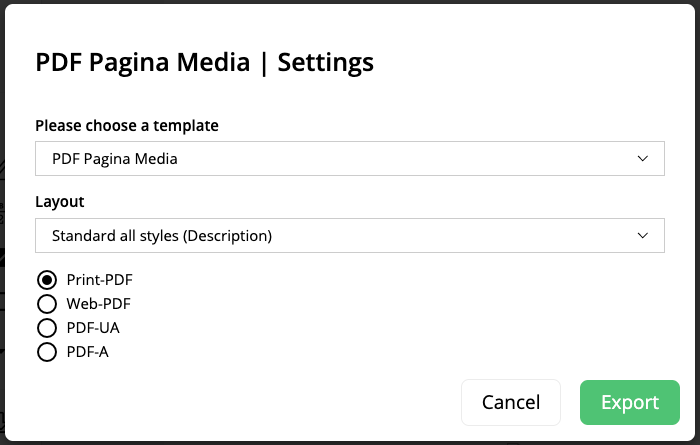
The field to choose a PDF template and layout of the exported document
The exported file will appear in the list of downloads in the upper right corner.
2What is the difference between templates in the line "Please choose a template" and "Layout"?
In dropdown menu in the line "Please choose a template" there are displayed PDF templates, in the line "Layout" Word templates are displayed that have been set for PDF export.
3Text of my document is not displayed in the exported PDF file, what should I do?
To have text from your document displayed in the final PDF file you should format text with the paragraph decorator Heading 1.
4In the export dialog window I see only the list of layouts displayed with radio buttons, where can I find the line to choose a template?
In this case it means that only one PDF and only one Word template have been set in your system. The principle of displaying dropdown menus for PDF and Word templates in PDF export modal window is the following:
●in case there are more than one PDF templates, you will see the upper dropdown menu "Please choose a template" (see Image 87);
●if there have been set more than 1 Word template together with PDF templates, you will get one more dropdown menu "Layout";
●when there is only one PDF template and more than one Word templates - only "Layout" dropdown appears
●when there are more than one PDF templates and only one Word template - only dropdown "Please choose a template" appears;
●if there are only two templates: one PDF and one Word, then only the list of layouts with radio buttons will be shown.
HTML export
1What HTML reports are available?
Documents can be exported as HTML pages or Audit Trail (HTML). You can also decide, whether you would like to export an HTML-file as URL or Zip-archive.
2Where can I find the exported HTML Zip-archive or the URL?
Zip-archive will appear in the list of downloads in the right corner above the page, the URL is exported in the separate URLs list.
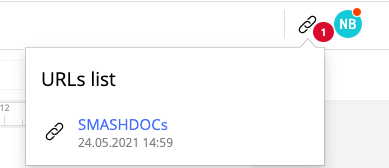
URLs list highlighted
3Is the URL of HTML-file public?
Yes. Any users can open this link and look through the exported document.
4How can the format Audit Trail (HTML) be useful for me?
The main advantage of the format Audit Trail is that it provides the user with entire information concerning the history of all changes while editing a document. When you export your document in this format, you are able to see all the comments added by all users working on this document, all changes in component, component history. Audit Trail format gives users the opportunity not to lose any important details during the whole process of document creation.
5Which details of document creation can I get in the Audit Trail (HTML) format?
The following information is displayed in Audit Trail (HTML):
●Date of creation of the document
●Name of the initial creator of the document
●Users contributing to the document
●Whether a user is Document Admin at the time the report was prepared
●Whether a user is active at the time the report was prepared
●Open changes in text components
●History to a text component, component versions
●History to an image component
●History to a table component
●History to an equation component
●Footnotes, footnote history and comments to footnotes
●Inline equations and history to an inline equation
●Inline files with a button to download a file
●Comments and all details about comment:
●Topic;
●Main comment;
●Metadata;
●Changes to comment's metadata;
●Replies to a comment;
●Time and date of creation;
●History to a comment which is visible for current user.
6Is it possible to delete URL from the list?
Yes, you can delete either one URL or all URLs, in case there are more than one in the list. For that click on the corresponding sign in front of each URL or on the button "Delete all".
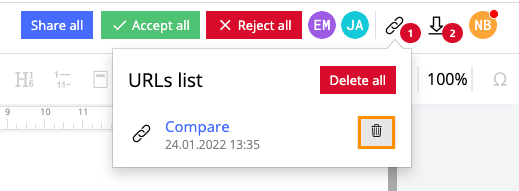
Button to delete the URL with the report "Audit Trail (HTML)"
Bibliography
1Is there a maximum number of bibliographies I can create in SMASHDOCs?
No, the number of bibliographies alongside the number of citations is not limited in SMASHDOCs.
2How can I add a bibliography in my document?
It is possible to add bibliography through the main toolbar and through the opened context menu at the cursor position. Also, you can create a literature entry manually or add references through the search in literature databases.
3Can I substitute some text in my document with a reference?
If you have decided to add reference by search in databases and have marked some text before, you can replace marked text with reference by ticking the required option before adding a reference.
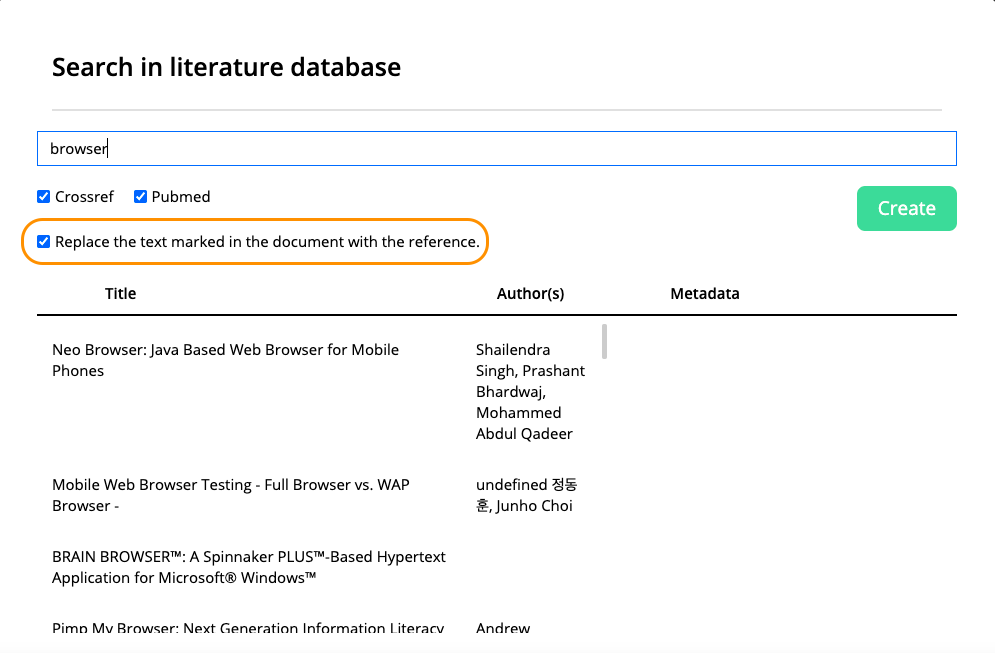
The option to replace marked text with a reference highlighted
4Which fields are obligatory to fill in, if I create a literature entry manually?
You must select the type of the entry and insert at least one field - title.
5If there is a word in my document which I'd like to replace with a reference, is it possible to do so?
Yes, you can do this with the option "Online search". Select the corresponding word in your document, open context menu and click "Online search". In the dialog window with results there will be option "Replace the text marked in the document with the reference". Tick this and the word will be replaced with the citation link.
6I want to place my bibliography at the beginning of the document, is it doable?
In SMASHDOCs table of contents, including bibliographies, are free positionable. You can decide where in the document it should be placed.
7Is it possible to follow changes in citations, in case I delete or edit it?
Yes, all changes in citations are tracked in the component history of a component, where this citation has been previously added.
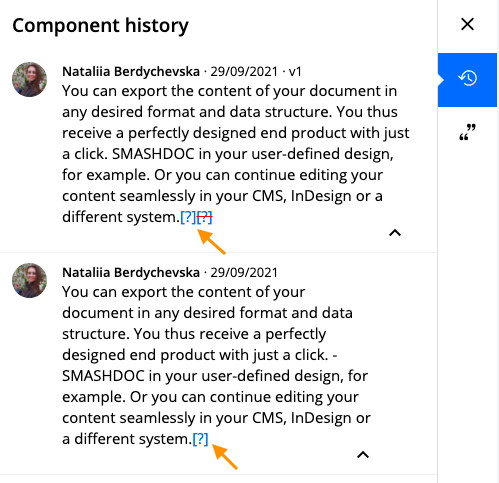
Tracking changes in citation in the component history
8Can I export the bibliography to Word?
Yes, you can export the bibliography. It would be displayed as a clickable link in a Word-document.
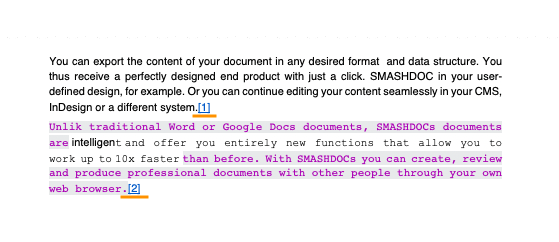
The citation and bibliography in Word after the export highlighted
9What happens when I click the citation link in Word?
After clicking a citation link, a web page will be opened in browser with the whole information about the literature reference.
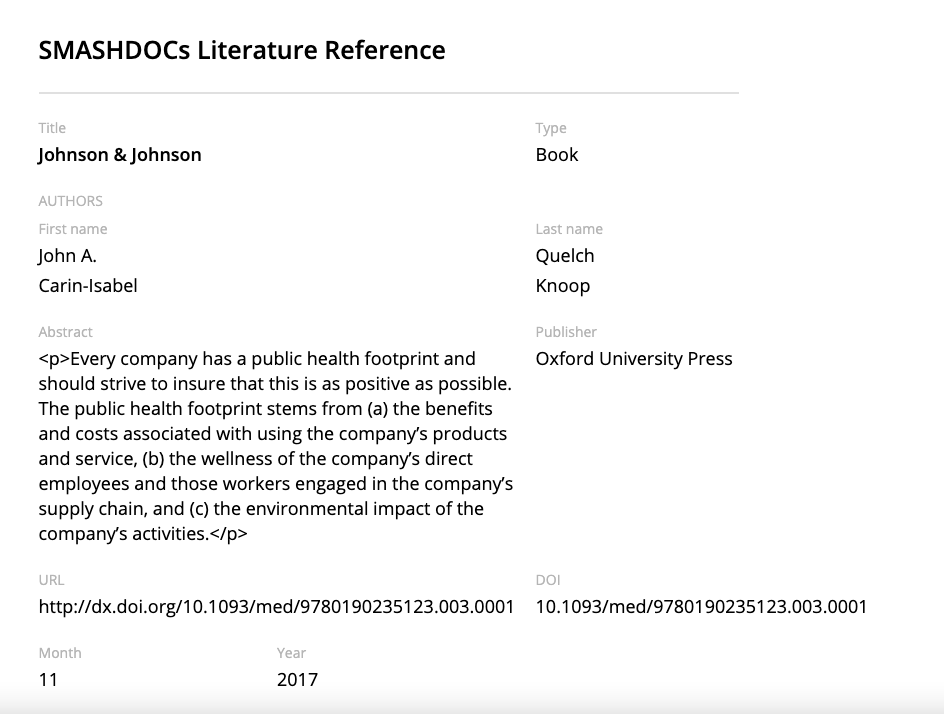
The information about the literature reference after clicking the citation link in the exported Word document
10There is no citation style I need for my paper. Is there a way to add more styles?
The Professional Services Team can configure additional citation styles upon request.
11Why is the number of bibliographies different under the Directories tab and Tables of contents?
Under the Directories tab, all the bibliographies created in the document are displayed, whereas under the table of contents only those bibliographies used in the text.
12What does the number near the literature entry in the table of contents mean?
This number means the number of times you have inserted the particular literature entry in the document.
13Can I change the presentation of literature entries in document?
Sure, in the document settings, you can choose whether literature entries should be displayed as numbers or as “none”, meaning with no icon.
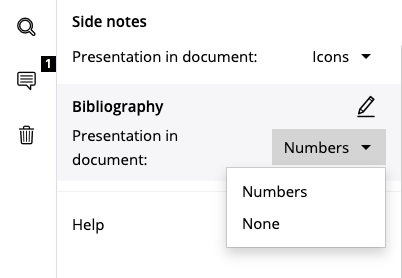
Options for bibliography presentation in the document highlighted
14How do I know whether I have already cited the literature entry in the document?
If you go to the Bibliography Management Page, you can find near each literature entry the tag "Cited" or choose the column “Cited literature entries” right away.
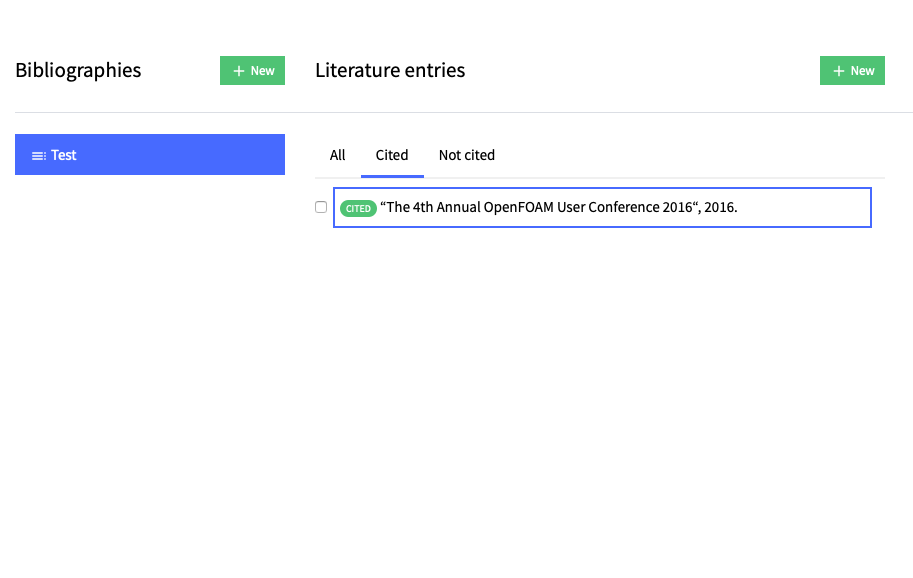
Cited literature entries highlighted
Search & Replace
1Can I search and replace text in combination with paragraph and inline styles?
Yes, under tab “Advanced search” you can indicate the search term, paragraph format and/or inline style. You can search for each element separately or use the full combination.
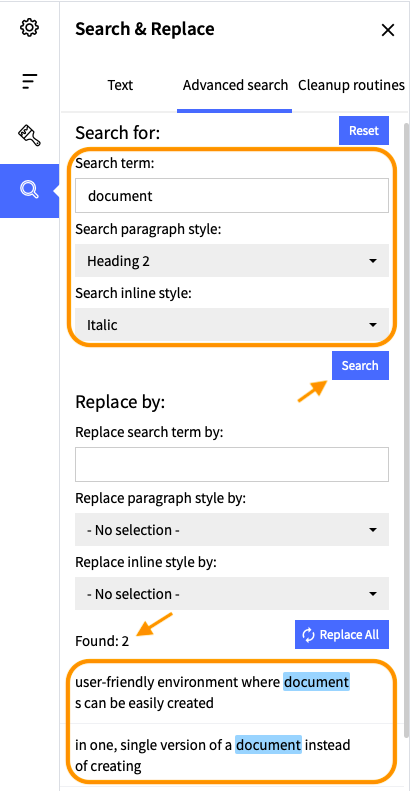
Advanced search and replace highlighted
2Can I search and replace special characters?
Yes, you can. Just insert the desired special character into the search term field and hit the “Search” button. Fill in the replace field with another special character. Afterwards, click on Replace near the desired search term or replace all founded search terms by hitting “Replace all” button.
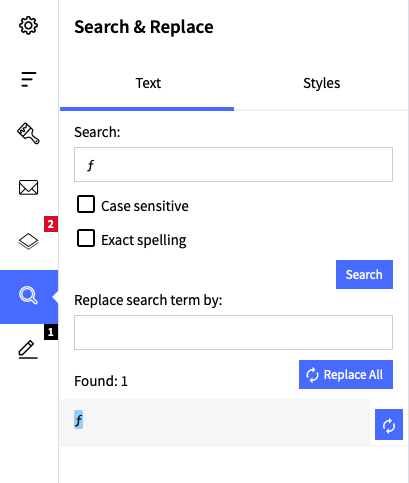
Search and Replace of special characters highlighted
3Can I search and replace footnotes?
Yes, you can. Just insert the footnote and hit the “Search” button. Fill in the replace field with content for new footnote and hit “Replace”. As always, you can either hit the “Replace” button near the search term you want to replace or hit the “Replace all” button right away.
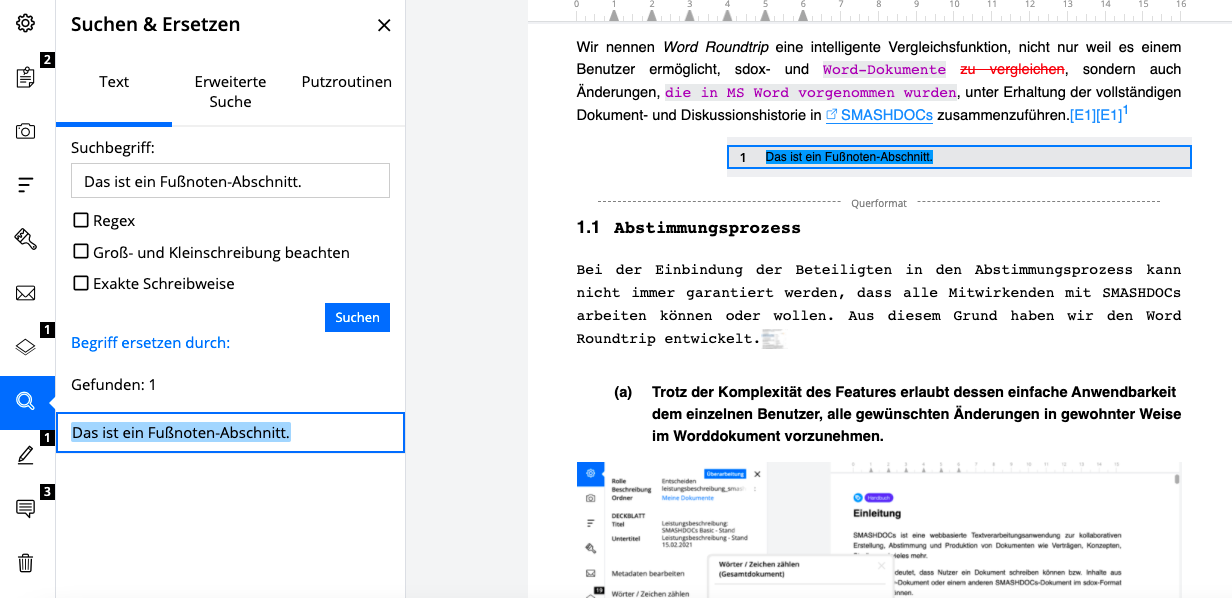
Search and Replace of footnote highlighted
4Can I search via regular expressions?
Sure. You can choose one of our predefined regular expressions or fill in the field manually with the desired regular expression. For this, go to the tab “Search and Replace - Text” and tick the “RegEx” box. After the search via regular expression is finished, you can hit the “Replace” button near the respective search term or replace all search term via the “Replace all” button.
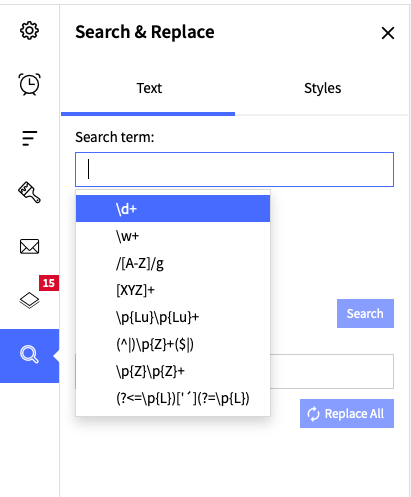
Predefined cleanup routines highlighted
Cleanup routines
1Can I clean up my document?
Yes, you can if you have the required right "Cleanup routines", which can be activated either during the invitation a user to a document or through user management. Just use our cleanup routines functionality and the variety of our predefined cleanup routines. You can select one, several or all cleanup routines at once and run them in your document. After the cleanup of your document is executed, all changes will be displayed as such. So, you can either accept or reject them. These changes are also tracked in the component history.
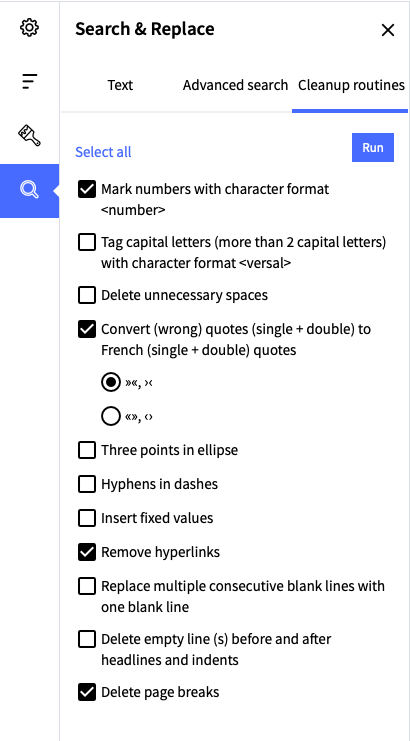
Cleanup routines highlighted
2What should I do if I have spare spaces in my document?
For this requirement the function "Cleanup routines" is available. In this function you have to choose "Delete unnecessary spaces" and this will be done automatically.
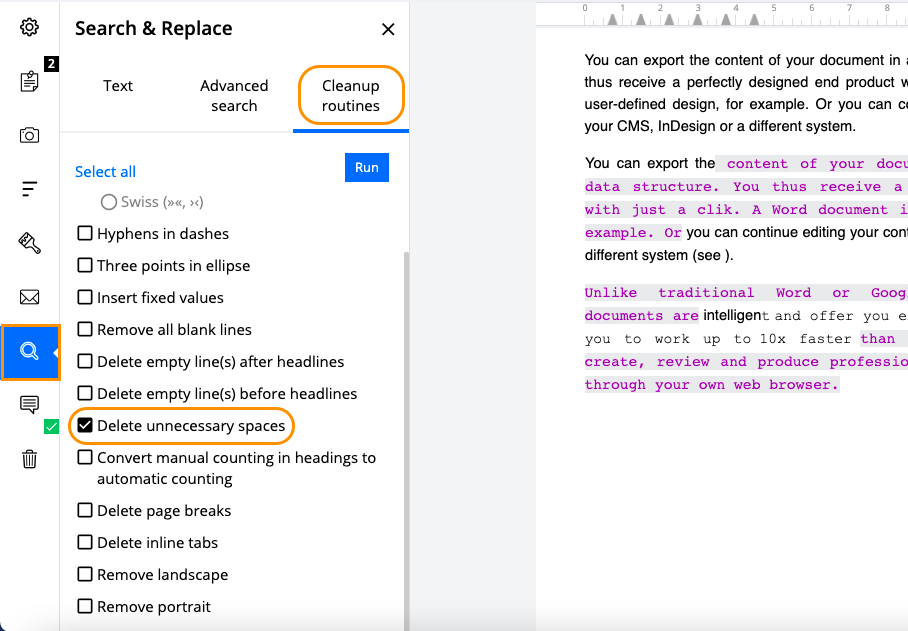
'Cleanup routines' and the function 'Delete unnecessary spaces' highlighted
3Which content does the cleanup routine "Delete unnecessary content after table and before table footnote" remove?
The following content is deleted by this routine:
●empty lines;
●portrait/landscape formats;
●underscore symbols;
●page breaks.
Creating versions
1I need to have a few versions of the same document at the different editing stages, how can I do this?
For this requirement you can create versions of a document at the desired stages of the negotiation. How to do this, look in the manual https://service-description.smashdocs.net/versions#ba821268-2f87-9c66-eb22-05dbc51a6630. The amount of versions of one document you may create is unlimited. You can also filter taken versions depending on their levels, add notes that will help you distinguish the purpose of the particular version or add any other information you need to. You are able to invite a user to your document as well, so that he/she can take versions. What you have to do for that see in the manual https://service-description.smashdocs.net/versions#9c44de73-f202-137f-9bd6-2aab7321bd9c. Moreover, you can compare all versions with each other and merge the necessary changes https://service-description.smashdocs.net/versions#79f2f957-f3e6-9d5f-a4aa-fbc060afa2cd and export them https://service-description.smashdocs.net/versions#875a8187-2697-4984-e424-0bd977c37813.
You can also save the initial version of the imported document in .docx format by setting up an automatic version creation. The manual edit when importing a Word document is also available.
2Can I know the exact time with the date of version creation?
Yes, you can find it right near the date of version creation.
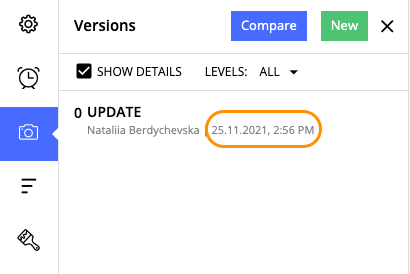
Exact time of version creating
Signing documents
1Can I sign documents in SMASHDOCs with electronic signature?
This function is available, if the module "Electronic signature by Signaturit" has been activated in the system. You can sign your digital communications with other users or your agreements with another counterparty in SMASHDOCs with the help of electronic signature tool - Signaturit.
2Which steps should I perform to start the eSign process?
To create an electronic signature, you have to click on eSign button in the tool bar above and insert a new placeholder. There are three obligatory fields to fill out such as the "First name", "Last name" and "E-mail". The other two, "Company" and "Position" are optional. They would appear pre-filled in case you've already provided this data during the registration or edited later in the user account.
3Can I change the "Position" field for the electronic signature?
Yes, you can. Simply type the new one in the placeholder for signer and this data will be displayed in the signed document. The other way how you can do it is through profile settings. As soon as you have changed "Position" field there, it will be automatically changed in the placeholder for signer.
4Can I follow the number of remaining signatures in my system?
Yes, there is such an opportunity. Total and remaining number of prepaid signatures in the system, as well as the end date of availability of remaining signatures can be found in the avatar-menu.
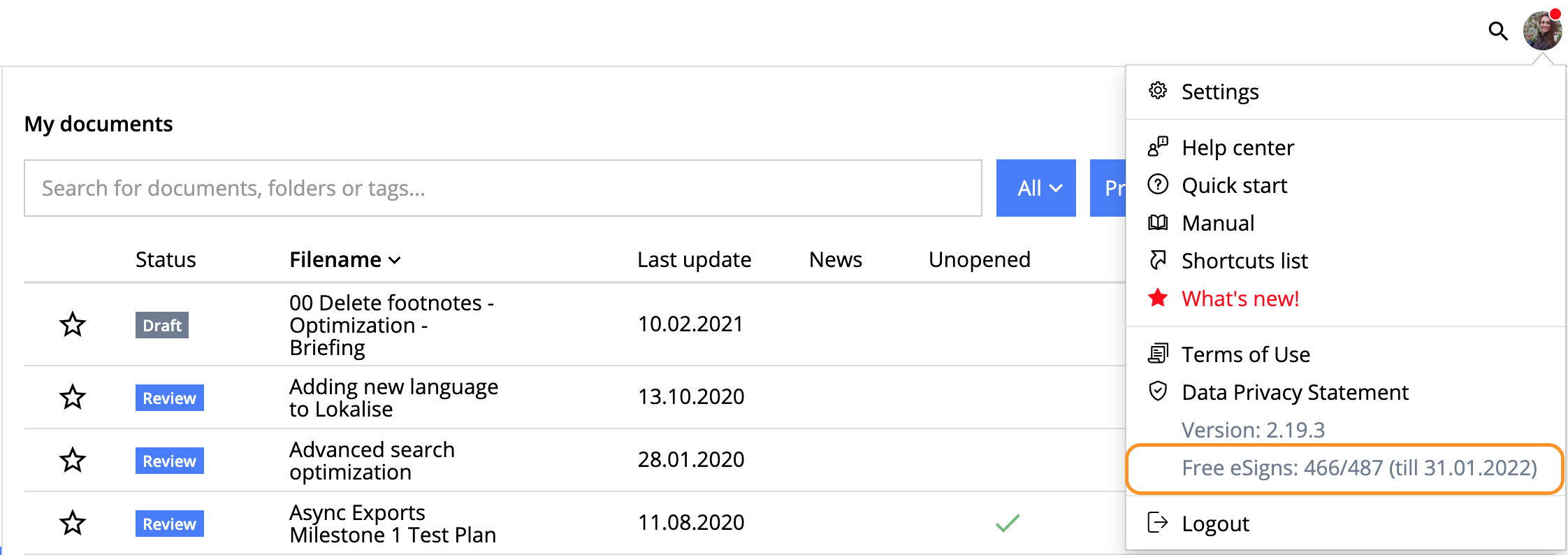
The total and remaining number of prepaid signatures in the avatar-menu
5Is it possible to create a version of the document that has been sent to signing?
Yes, there is such an option, if the module "versions" has been activated in your system. As soon as the document has been sent to Signaturit, a version of this document is automatically created. You can find this version in the versions tab left with default name "Sent for e-signature" and note "eSign provider: Signaturit". These fields are editable.
Excel connection
1How can I connect Excel with SMASHDOCs?
You can connect Excel to SMASHDOCs only from your OneDrive account. You should create an Excel table in OneDrive, then open the tab "Insert" in the upper toolbar, choose the option "Office Add-Ins" and upload an XML-file. Then your connection will be successfully completed and you can add your Excel tables in SMASHDOCs editor.

Option "Office Add-ins" highlighted
2Is an XML-file is unique for each system?
Yes, each system has a separate XML-file for uploading.
3How will I understand that Excel connection with SMASHDOCs has been finished?
As soon as connection is completed, you will see a SMASHDOCs-sign in the upper toolbar of the Excel editor.
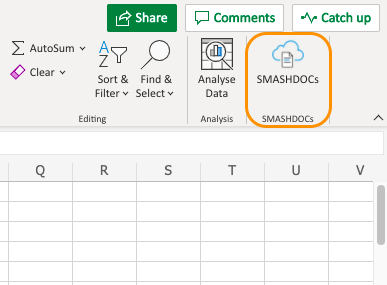
SMASHDOCs-sign in the Excel file
4How are SMASHDOCs table and Excel table differentiated in the document?
Excel table is displayed with a green Excel sign on the left.

Green Excel-icon in SMASHDOCs editor
5Can I add different sections of one Excel table separately in a document?
Yes, you can. In this case different sections will be displayed in SMASHDOCs as two separate tables.
6Is it possible to add two different Excel tables in a document?
You can connect the second table with a document, only if connection of the previous table has been completed.
7Why is my added Excel table is displayed without borders in SMASHDOCs?
If you do not add borders in your Excel table, this table will be displayed without borders in the document, as well.
8If I do not need the table to be connected with Excel anymore, but want to save this table in the editor as SMASHDOCs table, can I disconnect the table from Excel?
In this case you can remove connection in Excel. This option you will get after clicking SMASHDOCs sign. After that, your table will not be displayed with a green Excel sign anymore.
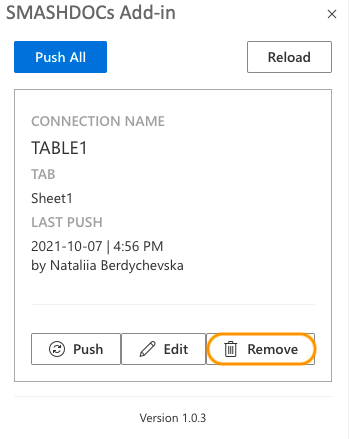
The button to remove the connection of an Excel table
Other
1Where can I store the documents besides the SMASHDOCs platform?
Thanks to one of our integration, you can save and share your files in Dracoon that provides transparent and reliable data sharing. You can be registered in the DRACOON platform either by admin or user with special rights if you already own a SMASHDOCs account. In case you create a new account in the SMASHDOCs system where Dracoon integrated, automatically you'll get a new account in the Dracoon platform.
